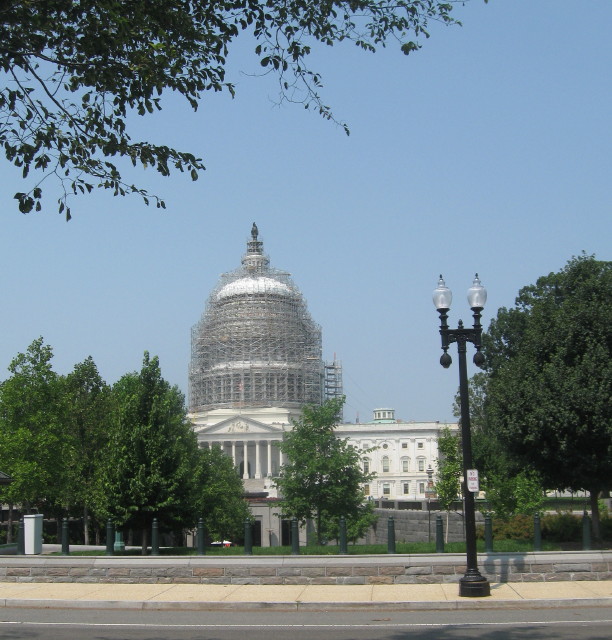Adventurers in New England
Chapter Twenty-Four
Train Ride from Norfolk to Washington D.C.
Northeast Regional # 174
U.S. Capital, Mall, American History Museum, Jefferson
Memorial
Washington, DC
Overnight on sleeping car to New Orleans
Amtrak Crescent # 19
by
Robin Bowers
July 1, 2015
Wednesday
Text and Photos by Author
The author retains all
rights. No reproductions are allowed without the
author's consent.
Comments are appreciated at... yr.mmxx@gmail.com
It was deep in the dark of
night that Chris and I escaped the warmth and comfort of our
room at the Tazewell. Our taxi took us the short distance
to the Norfolk Amtrak station, next to Harbor Park. If the Tide
had been running at this damn awful time, we would have taken
it.
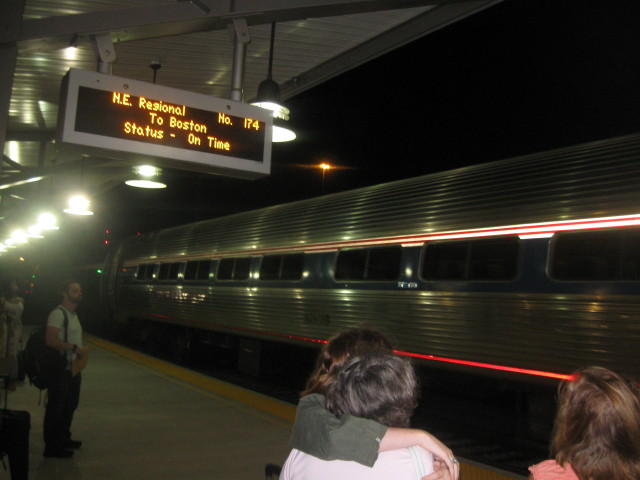
# 174 ready for on schedule departure at 5:00 AM.
Chris has planned
our departure from Norfolk by a different route than how we
arrived, all of which were new to me. Rather than going back
across the bay, we would go inland and around the water. Our
first stop would be Petersburg, about 30 minutes from
Richmond. From Richmond to DC we would be traveling on
previous tracks covered on Monday. Train # 174 runs Monday
to Friday leaving at 5:00am and #88 runs Saturday and Sunday
with a 6:15am departure. These are the only two trains
serving Norfolk, however, there are also two bus
departures. We boarded and found our seats. All the
passengers quietly boarded and settled in for some quiet
time in the dimly-lit car. We were pleased that the Wi-Fi
worked so we could get on the computer during this trip.
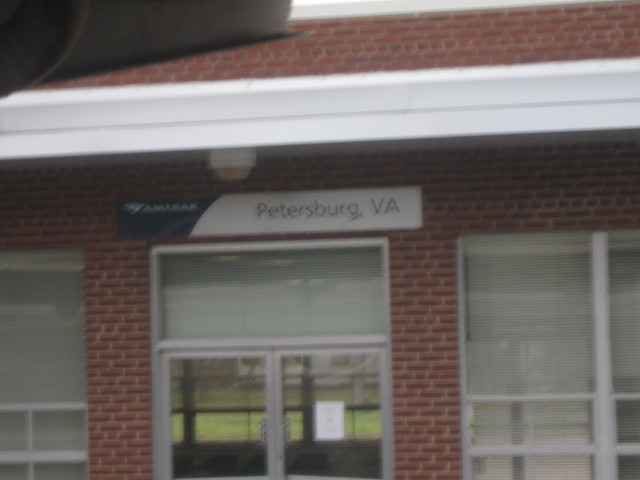
Petersburg began in
1645 as Fort Henry, a frontier fort and trading post. In
1781 a British force under Generals William Phillips and
Benedict Arnold marched on the town, which was
inadequately garrisoned by 1,000 men under Maj. Gen.
Friedrich Von Steuben. After a short skirmish to cover
his retreat, von Steuben withdrew across Pocahontas
Bridge, burning it behind him.
The 2,659-acre Petersburg National Battlefield two
miles east of Petersburg was established to preserve and
interpret the battlefields where ten months of grim
trench warfare sapped the strength of Gen. Robert E.
Lee's Confederate Army and led to the fall of Richmond.
Petersburg was an important point through which supplies
moved to Richmond, as five railroads converged at
Petersburg with only one line leading to the capital
city.
Chris finished up the Amtrak system
as we came onto the CSX mainline in Petersburg, Virginia
and I took pictures with his camera as he did it.
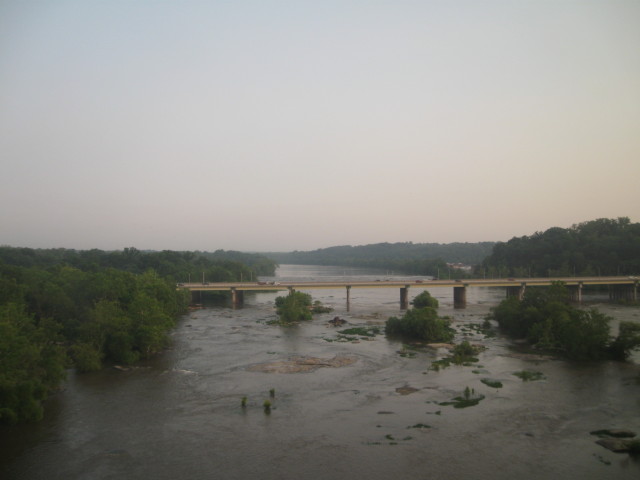
Some of the many area's waterways.
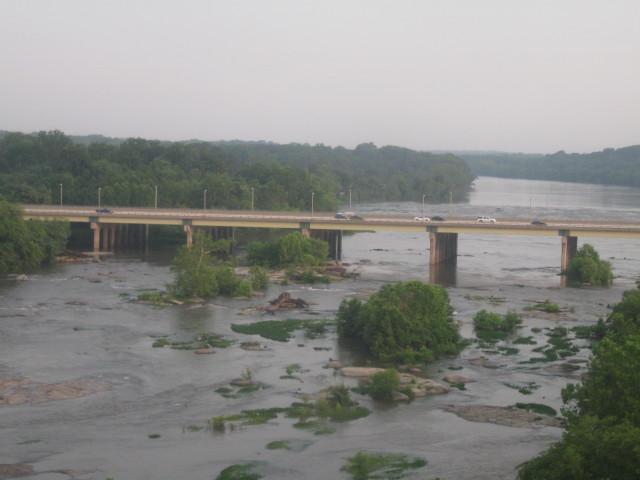
James River.
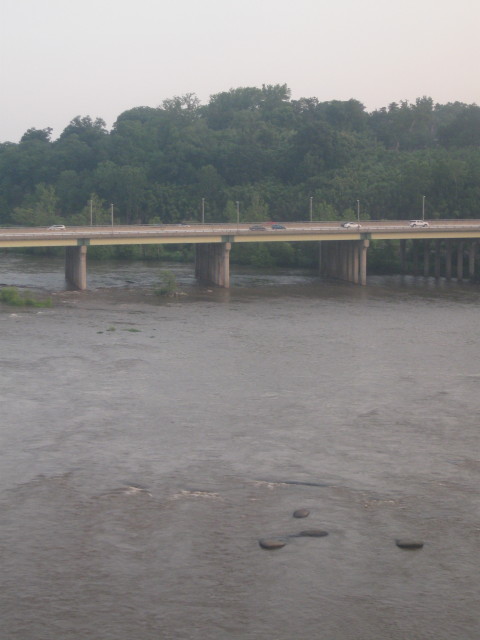
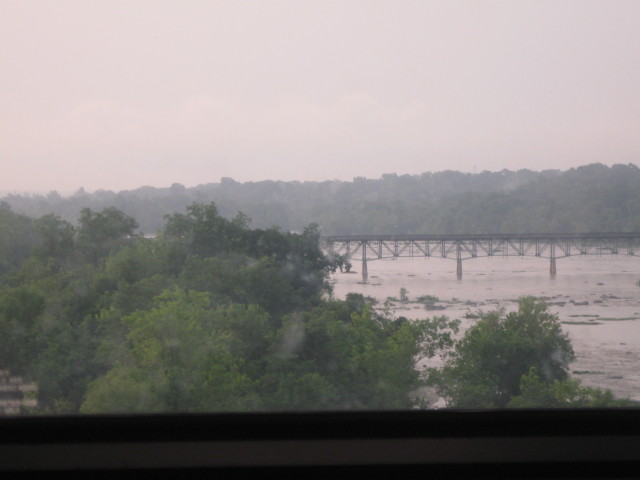
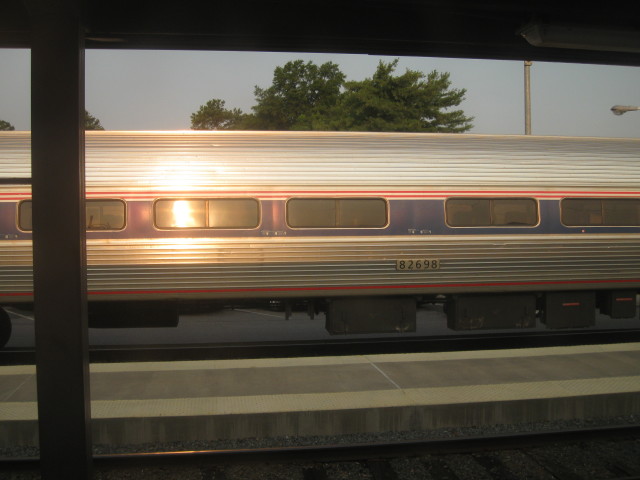
At Richmond station.
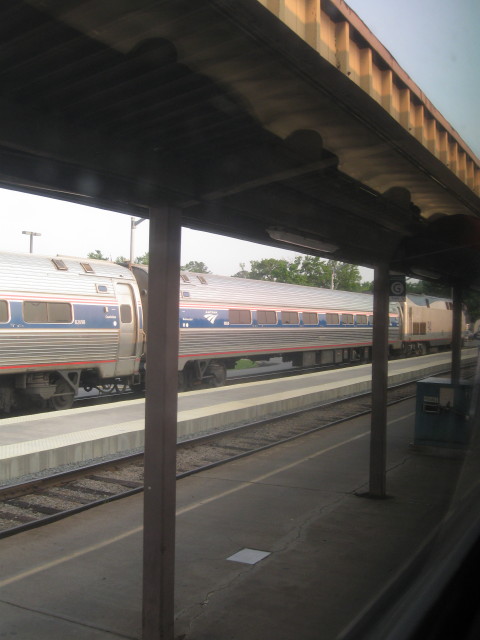
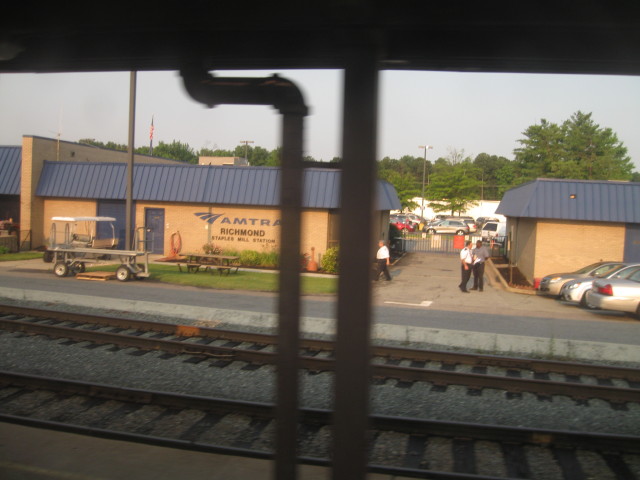
Richmond, VA, Staples Mill Road Station.
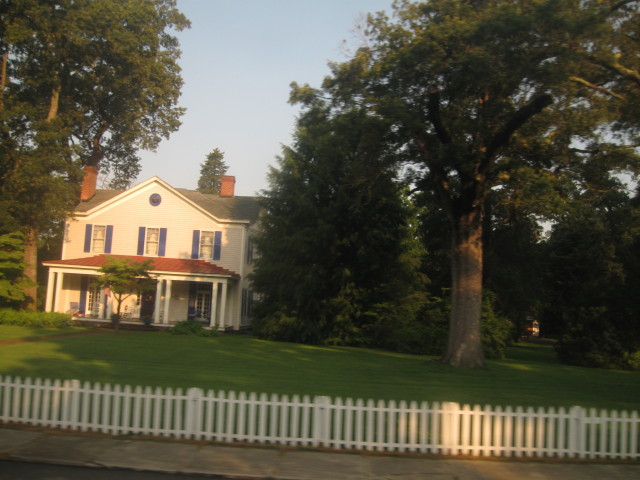
My country home with white picket fence.
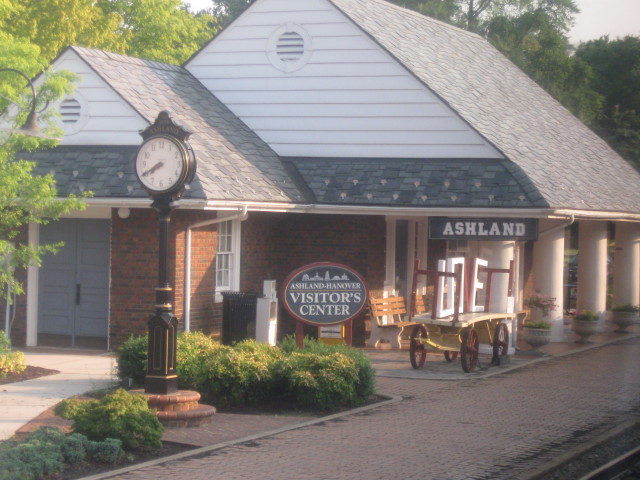
This turn-of-the-20th-century
railroad town originally was developed as a resort for Richmond
residents. Later, the growing village assumed the name of a
Kentucky estate belonging to Henry Clay, a statesman born
nearby. When the railroad company gave land to the Methodist
Church in 1866, the church moved its Randolph-Macon College to
Ashland.
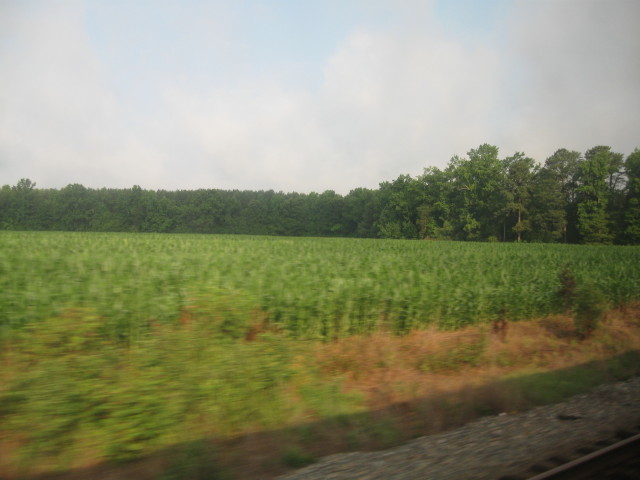
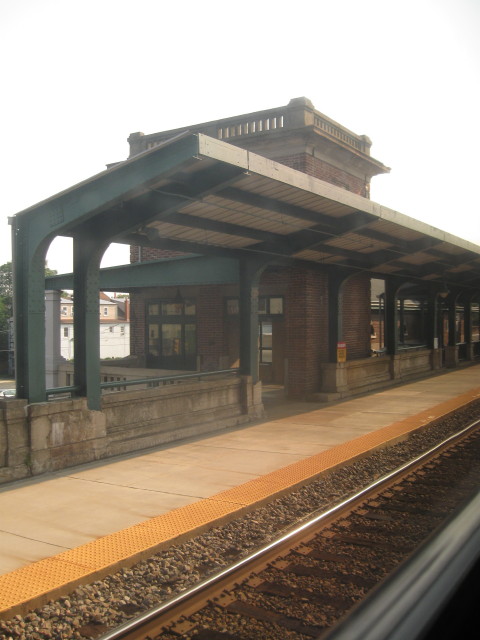
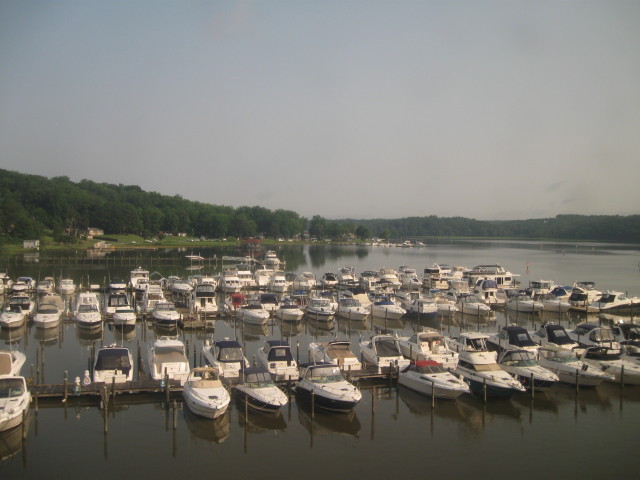
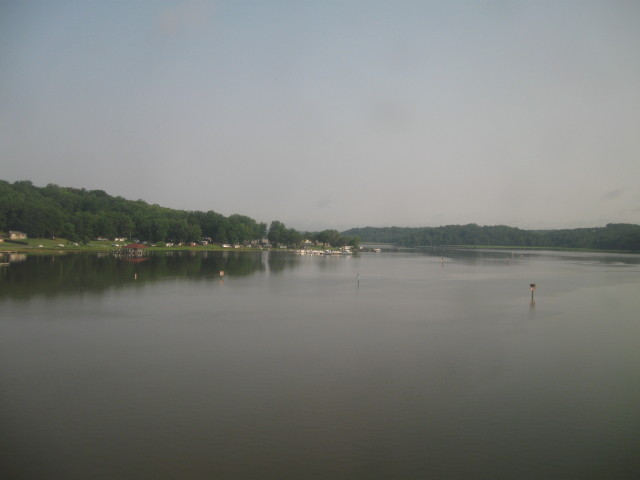
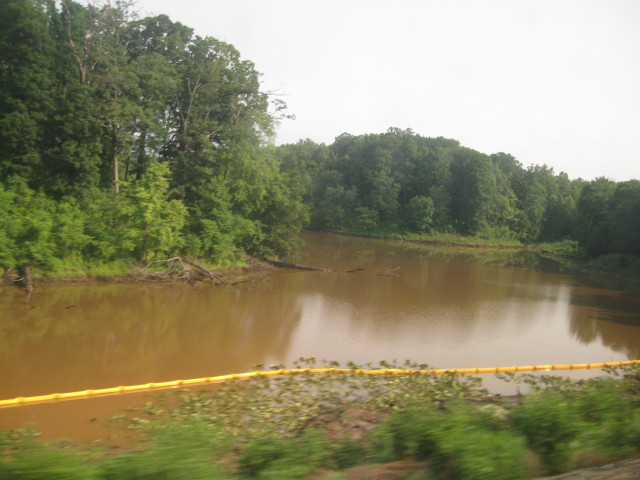
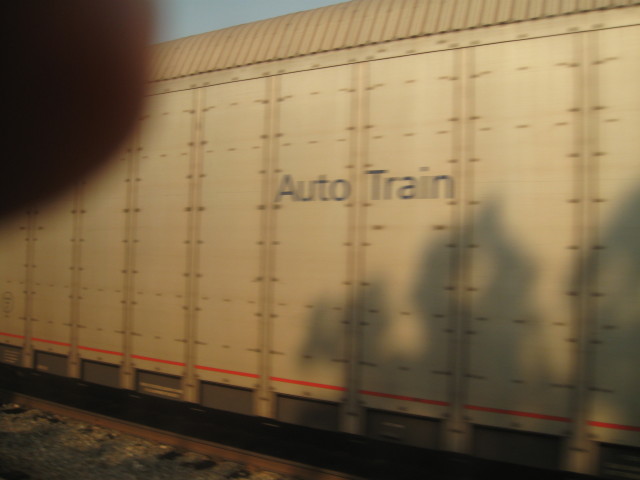
Auto train after its arrival from Sanford, FL in Lorton, VA.
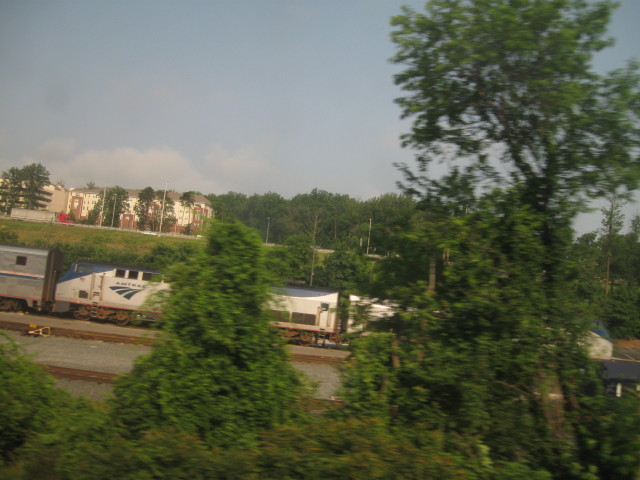
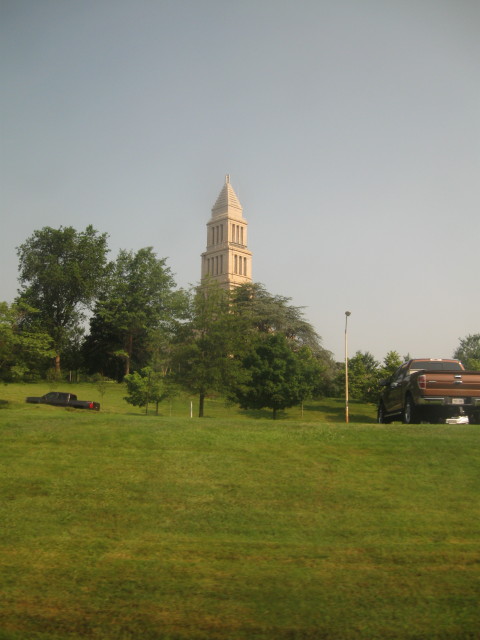
Alexandria, VA.
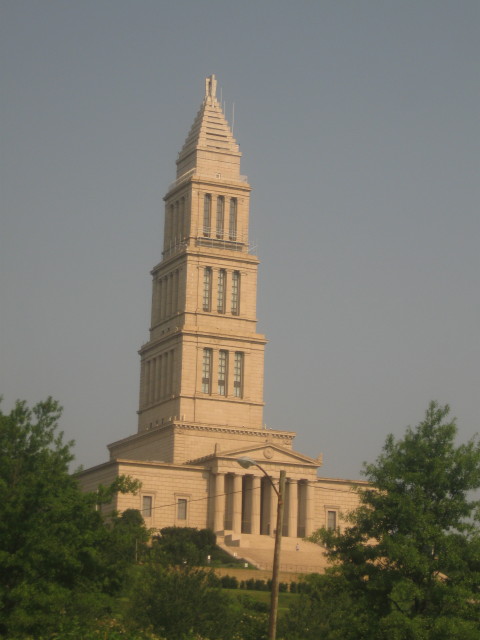
The George Washington Masonic National Memorial.
The 333-foot-tall landmark
was inspired by the ancient lighthouse at Alexandria, Egypt. The
Replica Room contains original furnishings of Alexandria Lodge
No. 22, the lodge in Alexandria over which Washington was the
first Worshipful Master under Virginia charter.
If you are ever in the Alexandria area,
please stop and visit here. I found my visit educational with
such relics as a Washington family Bible, and a introduction to
the symbols and allegory of the fraternal organization. Exhibits
include The Family of Freemasonry, which explains the diverse
world of the Masonic fraternity.
District of Columbia
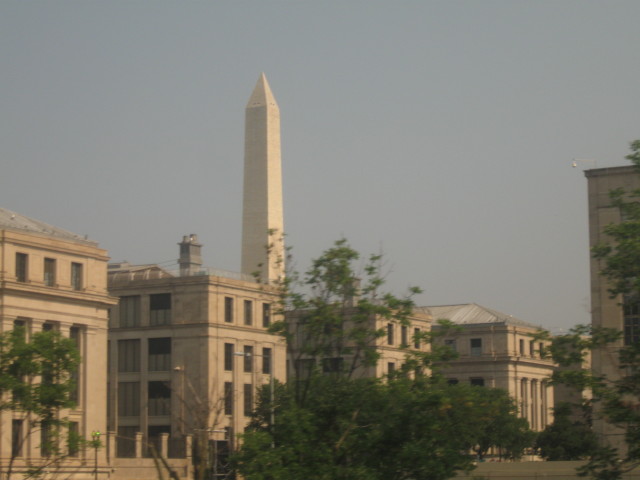
Washington Monument.
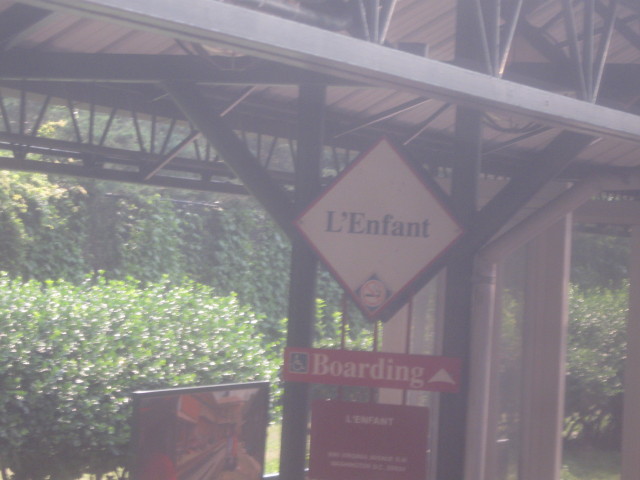
L'Enfant Plaza Metro stop.
The task of designing the
republic's permanent capital fell upon French-born architect
Pierre-Charles L'Enfant in 1791. His vision included two focal
points: the Capitol and the President's Mansion. He placed these
structures just far enough from each other to reinforce the
separation of powers between the legislative and executive
branches of government.
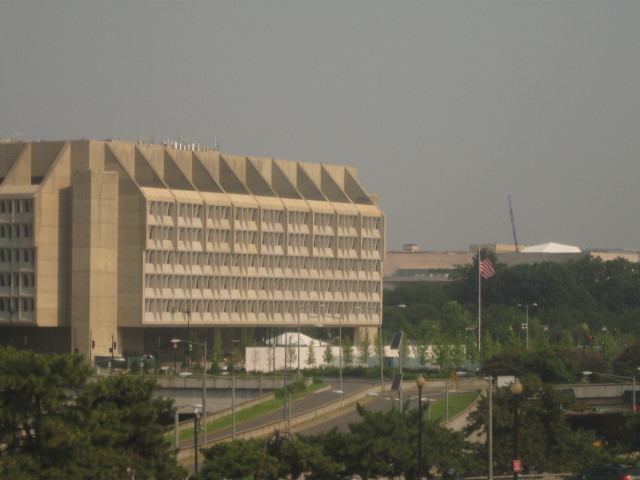
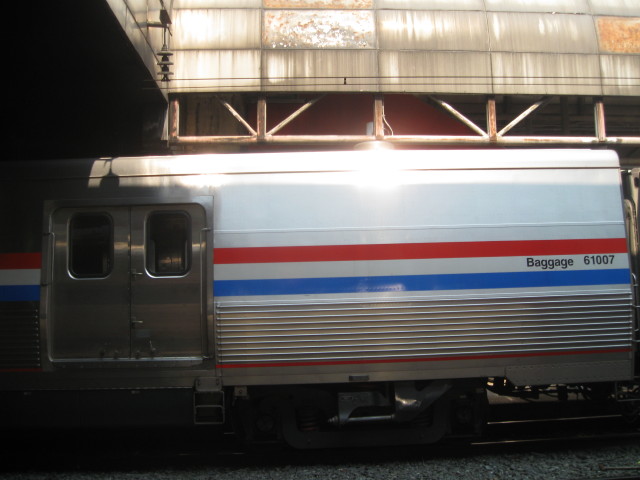
After our arrival in Union Station DC., I saw my first new baggage
car.
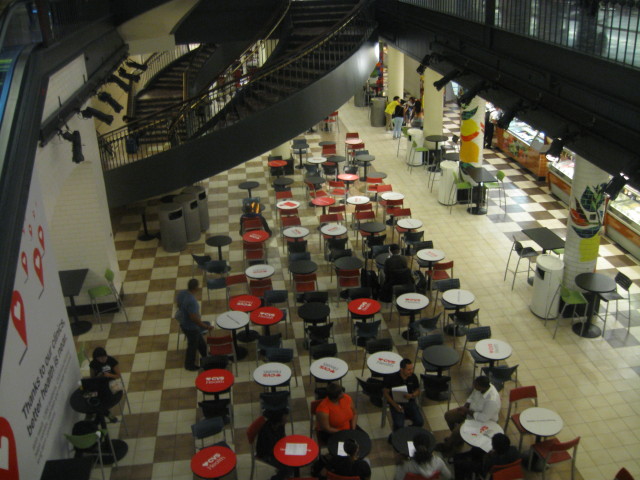
Food Court on bottom floor of Union Station.
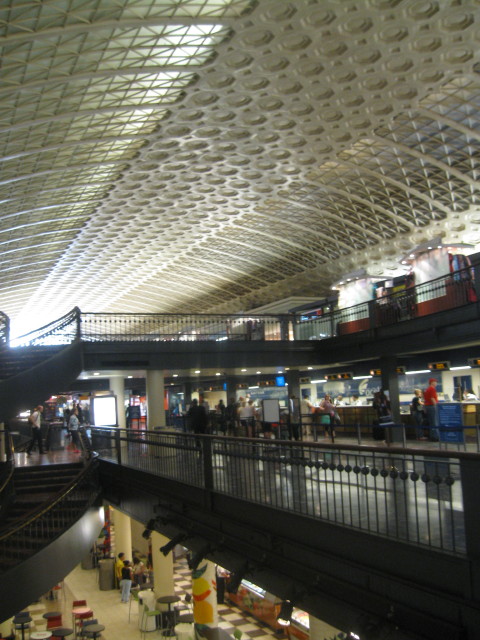
Main floor with Amtrak ticket sales and boarding areas. Top floor
has shops and restaurants.
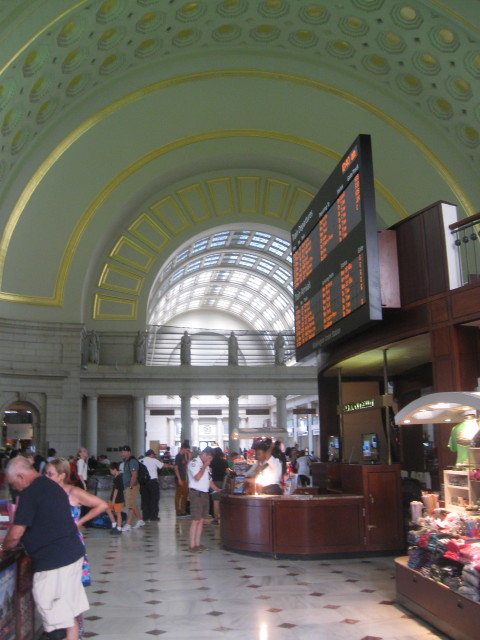
Built in 1907 during the
heyday of railway travel, the Beaux Arts-style Union Station
served as the gateway to Washington. Inspired by ancient Roman
baths and triumphal arches, architect Daniel Burnham designed
the station's main hall, distinguished by a 96-foot-tall
barrel-vaulted ceiling made up of recessed, gilded panels.
Statues adorn both the exterior and interior; a few of the 46
Roman legionnaires encircling the main hall were redesigned due
to concern that their skimpy uniforms might scandalize
passengers.
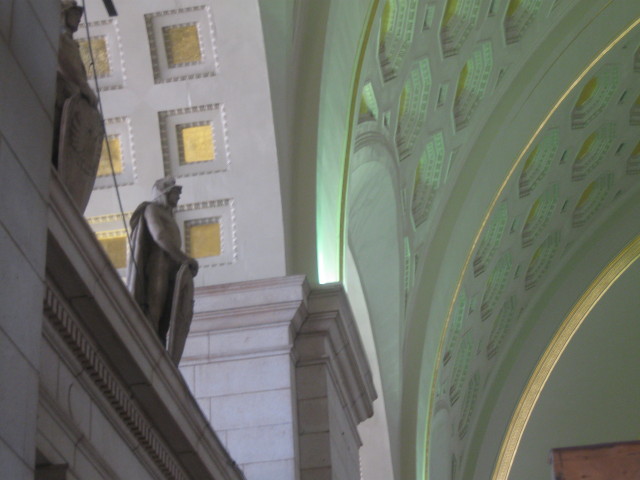
It was a little after 10:00am
when Chris and I checked our bags in the ClubAcela. This service
at the private lounges is great for leaving your luggage while
occupying your time between trains. I wanted to see the Mall and
some museums while Chris wrote his stories in the lounge as he
waited for his train.. Tonight we would go our separate ways
after three weeks of traveling. He was going home via Chicago
then the California Zephyr. His Capitol Limited departs at
4:05pm with arrival in Chicago at 8:45am.
I am taking the southern route home.
The Crescent to New Orleans departs here at 6:30pm with arrival
tomorrow night at 7:30pm. then a Fourth of July weekend lay
over, after which will be my last train train ride - to home. I
will be taking the Sunset Limited from end point to end point.
This will be my first time on both trains and all new trackage
for me.
After having decided that I need to return to
the station by 6:00pm, I left the station and walked across
Columbus circle to the US Capital.
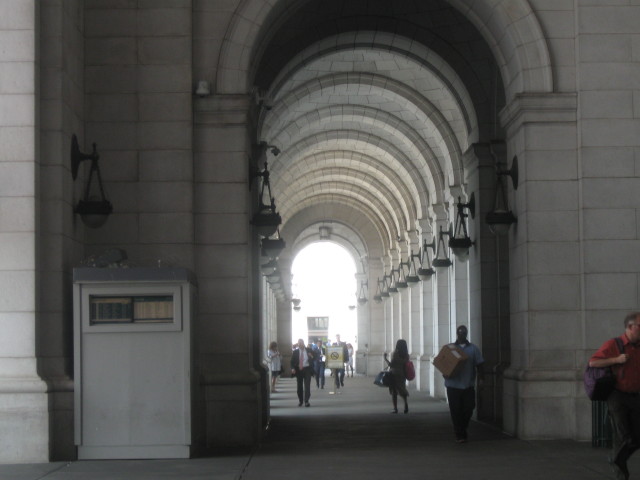
Outside Union Station.
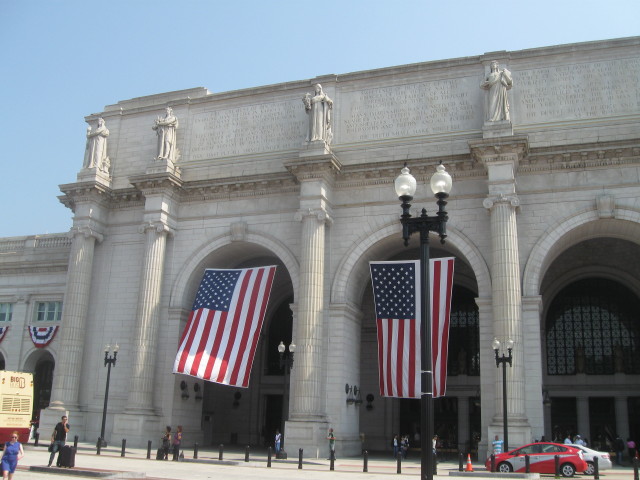
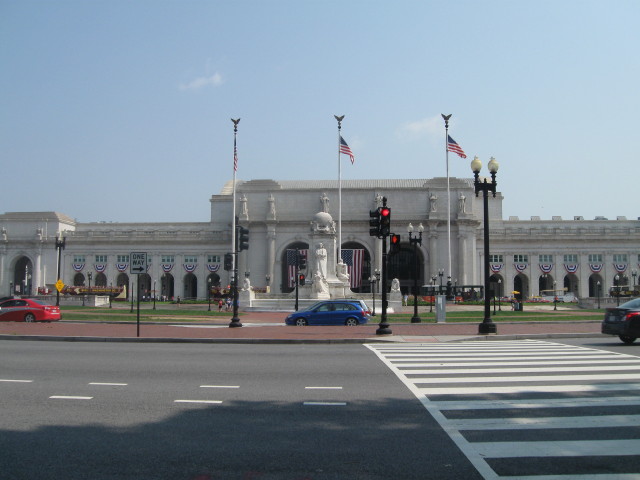
A 1912 monument to Christopher Columbus made up of three
flagpoles, a semicircular fountain and a 15-foot statue of the
explorer, who faces the Capitol.
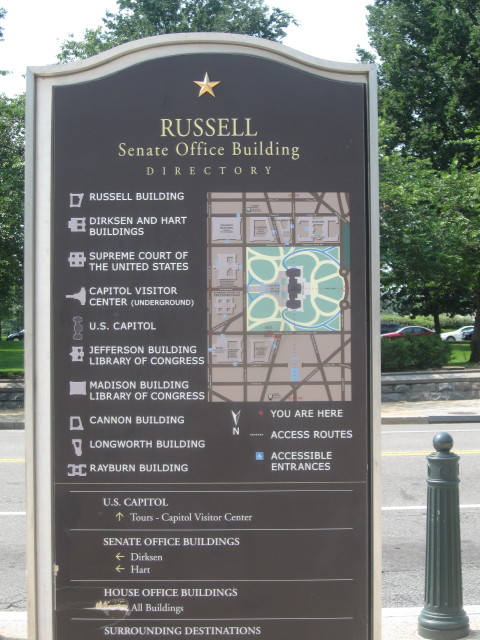
r
After crossing Columbus circle, I walked down
1st Street approaching the Capital. The north side is the
Senate's hood with its office buildings. The south side is
overseen by the House gang. The west side is used for the
inauguration ceremonies and the east side faces the Supreme
Court and Library of Congress.
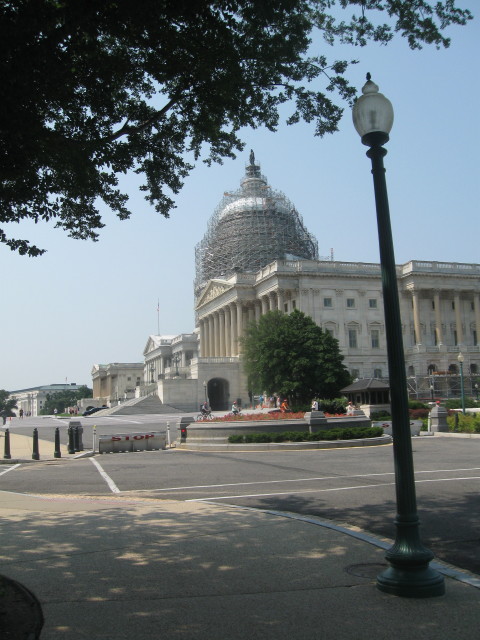
East side with Senate building nearest.
Although the United States
Capitol is not located at the geographical center of Washington,
D.C., it is the origin point where the District's four quadrants
meet. Pierre Charles L'Enfant's plan for the new federal city
called for an inspiring domed structure atop Jenkins Hill - or
as the French-born architect and engineer referred to it in
1791, "a pedestal waiting for a monument."
The quadrant initials - N.W., N.E., S.W., and
S.E. - are an integral part of any Washington address; they
determine which of four possible location is correct.
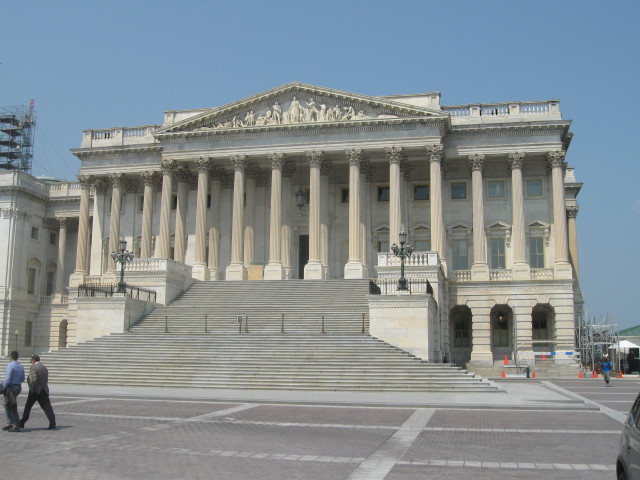
Senate building east side.
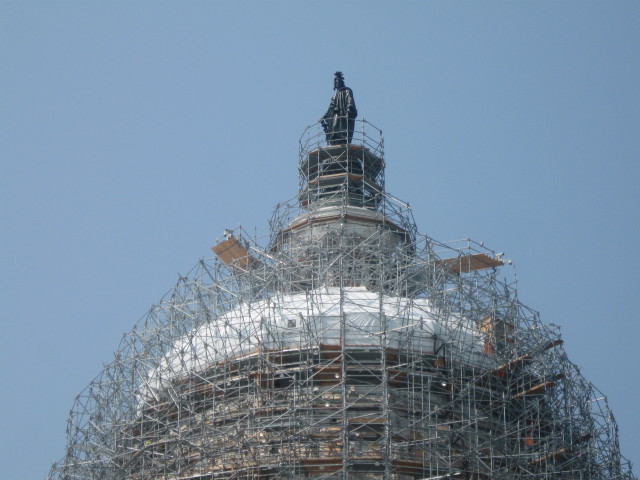
Statue of Freedom.
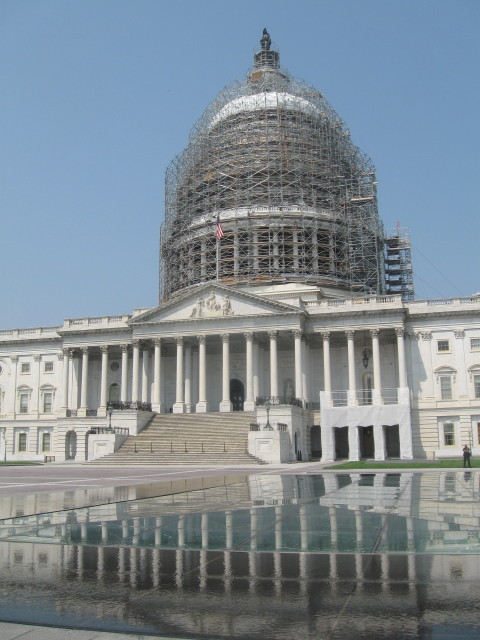
East side.
The site for the seat of the
federal government was selected by George Washington and Pierre
L'Enfant; Washington laid the cornerstone on Sept 18, 1793. This
monumental building - based on Dr. William Thornton's 1792
design with revisions and expansions by subsequent architects
over a 200-year period- is 751 feet long and 350 feet wide at
its widest point. It contains approximately 540 rooms. The
19.5-foot-tall Statue of Freedom is located atop the cast-iron
dome.
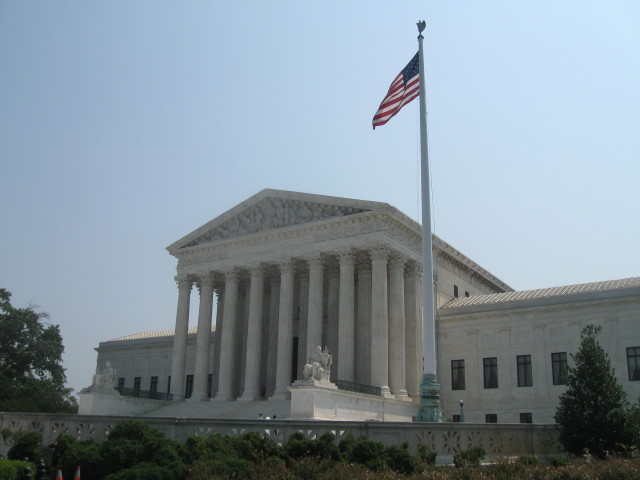
Supreme Court Building is at
1 1st St. N. E. between Maryland Ave. and E. Capital St. N.E.,
facing the Capitol. The country's highest judicial body holds
its sessions at this imposing white marble edifice, anchored by
lofty Corinthian columns. Although the Supreme Court began
hearing cases as early as 1790, the building, design by noted
architect Cass Gilbert, was not completed until 1935; prior to
that the court sat in various locations.
Inscribed over the entrance is the court's
statement of purpose: "Equal Justice Under Law." Panels on the
massive bronze doors depict the history of the development of
law. All sessions are open to the public; seating is on a
first-come, first-served basis. I have had several meals at the
lunchroom located in the building. The seated female figure to
the left is titled "Contemplation of Justice," while the male
counterpart opposite her is called "Guardian of Law."
View from steps of Supreme Court on 1 st. Street.
Leaving the Capital grounds,
I cross 1st St. to the Supreme Court side and walk down it to
the Library of Congress at 1st and Independence Av.
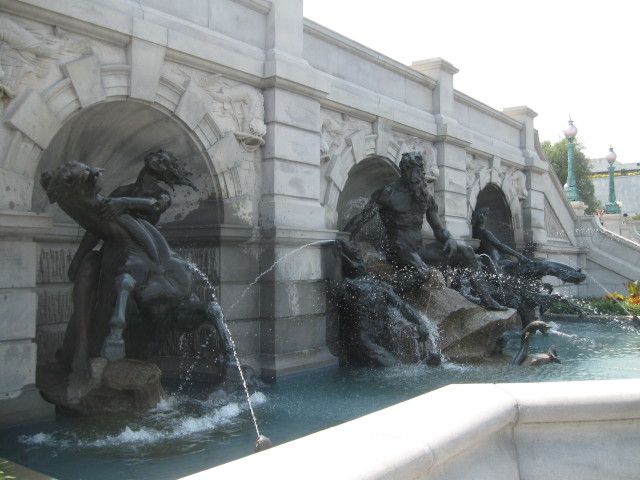
A beautiful fountain along1st Street features the Roman god
Neptune and his court greets you at the Jefferson Building.
Library of Congress is across
from the United States Capitol at Independence Ave. and 1st St.
S.E. All told, the collections housed in this three-building
complex number more than 160 million items, including more than
37 million books and other printed materials; millions of
manuscripts; and voluminous collections of maps, prints,
photographs, musical scores, recordings, newspapers and the
papers of 23 U.S. presidents.
The library's beginnings were humble in
comparison; it was founded in 1800 to serve the needs of
congressional members, and the small collection of books was
housed in the United States Capitol. Thomas Jefferson's personal
collection of nearly 6,500 volumes, now displayed in Thomas
Jefferson Building, was purchased by Congress after the original
collection was destroyed when British troops burned the city in
1814. It formed the basis on what was to become the national
library.
James Madison Memorial
Building, at 101 Independence Ave. S.E. across from the Thomas
Jefferson Building, is one of three buildings comprising the
Library of Congress. Opened in 1980, it is contemporary in
design and contains reading rooms. Two areas, the Performing
Arts Gallery and the Geography and Map Corridor, have rotating
exhibitions. On the top floor is a lunchroom with views looking
southwest towards the Navy Yard, the Potomac River and
Washington National Airport. I have dined there several times
during my visits.
John Adams Building, e. of the Thomas
Jefferson Building on 2nd St. S.E. at Independence Ave. S.E., is
one of three buildings comprising the Library of Congress. This
1939 Art Deco edifice offers a general business and science
reading room that is open to researchers only.
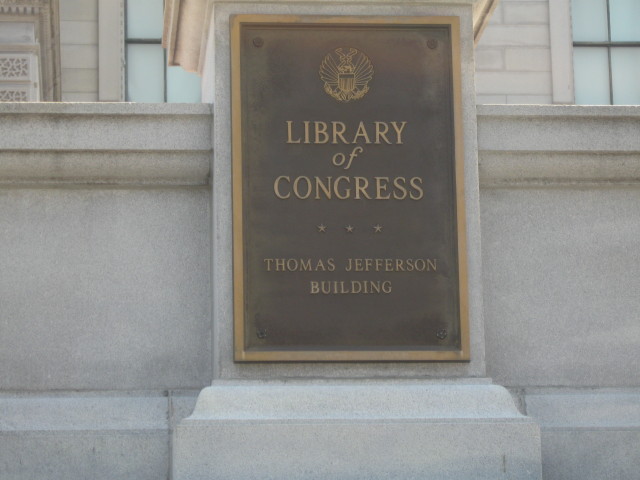
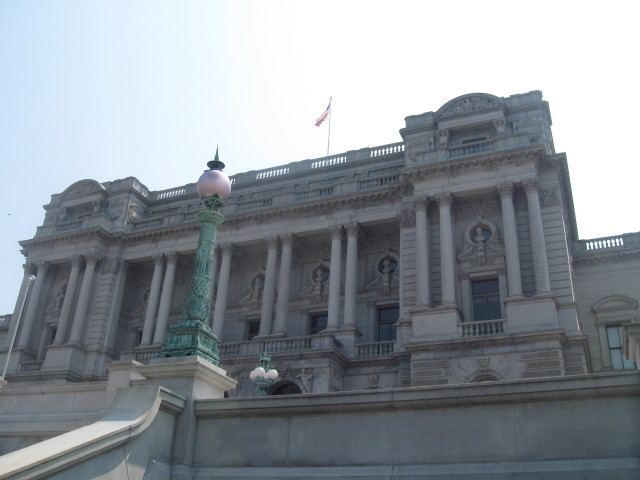
Framed by circular windows are the busts of nine important
authors.
The first
of the three to open in (in 1897), the Jefferson Building also
stands out for its richly ornamental Italian Renaissance
architecture. The octagonal Main Reading Room is visually
stunning, a feast of elaborately painted vaulting, sculptures,
paintings, murals and mosaics. Walk-in visitors can view the
room from the Visitors Gallery. It is definitely worth a stop
just to view the room.
Passing the Jefferson Building, I turned
right and headed west on Independence Ave to my next stop. It
was after a few visits to D.C., that I had my first encounter
with this sweet gem and now I try to visit on every trip. If you
need a few minutes of peace and quite, come to this secret
place.
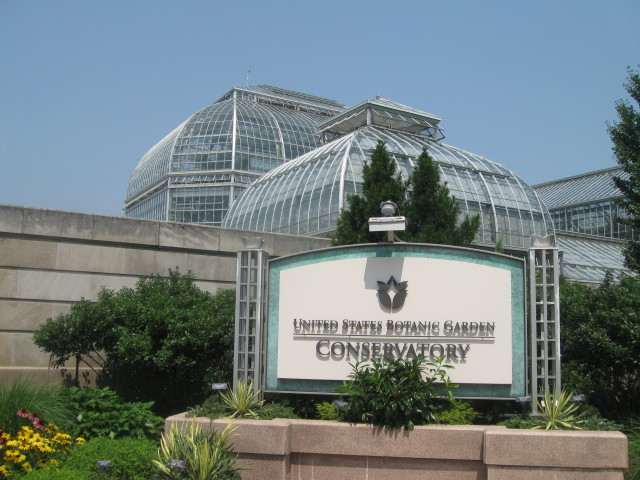
United States Botanic Garden
is at 100 Maryland Ave. S.W. on the w. side of the Capitol
between Maryland and Independence Aves. S.W. Open to the public
since 1850, it celebrates plants as living things that not only
display an incredible range of beauty but provide livelihood and
meaning to cultures around the world. Better yet, this is a
wonderfully relaxing change of pace from D.C.'s hustle and
bustle.
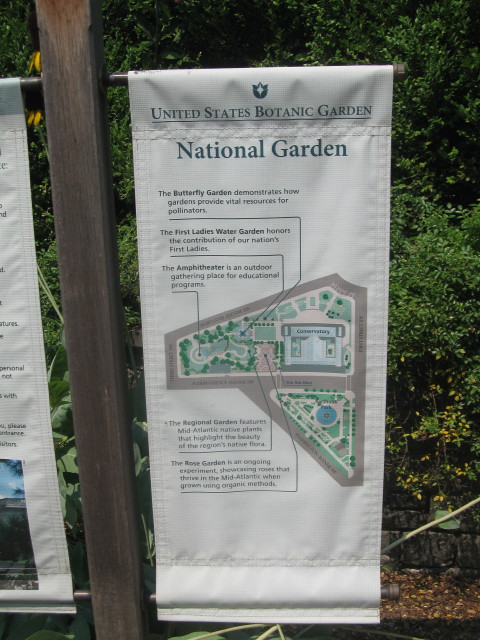
The National Garden,
adjoining the Conservatory, is an outdoor garden that's at its
best in the summer. The First Ladies Water Garden is a beautiful
place to sit by a fountain and relax. The national flower is
saluted at the Rose Garden; plants in the Butterfly Garden
attract you know what.

The Regional Garden, above, features species native to the
Mid-Atlantic region, which has an uncommonly rich variety of the
flora due to its location between colder and warmer sections of
the country.
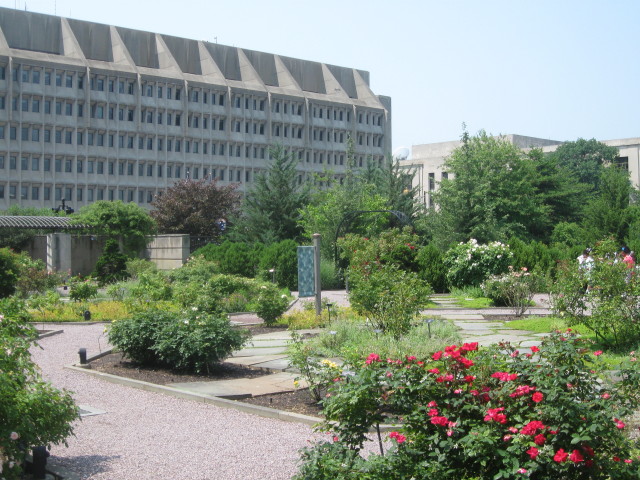
The Rose Garden is an ongoing experiment, showcasing roses that
thrive in the Mid-Atlantic when grown using organic methods.
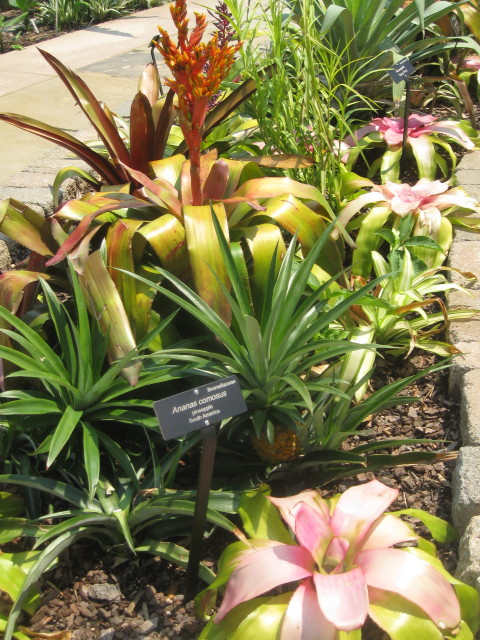
Bromeliaceae, Ananas Comosus, pineapple, South America.
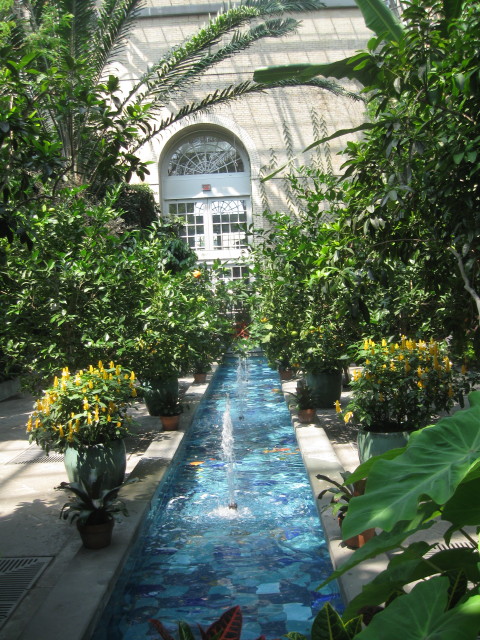
The glass-walled Conservatory
is the garden's indoor facility. Enter into the Garden Court, an
oasis of lush greenery, exotic flowers and two skinny reflecting
pools, with wooden benches where you can sit for a spell. Most
of the Conservatory is given over to lofty palms, hardwood trees
and foliage plants luxuriating in a climate-controlled
environment. Climb up the Canopy Walk, a metal stairway that
offers various bird's-eye perspectives of the tropical habitat.
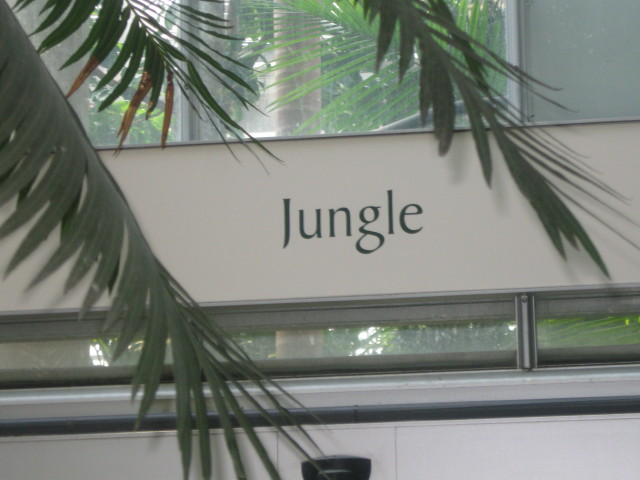
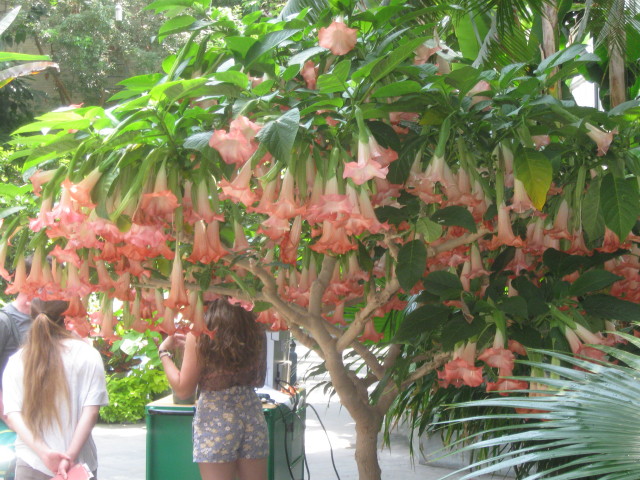
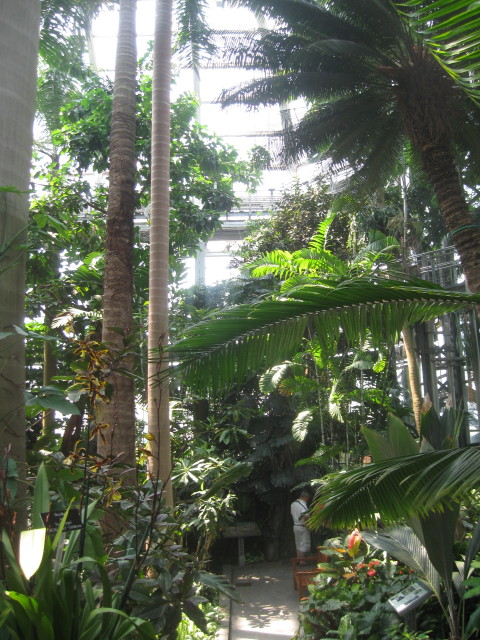
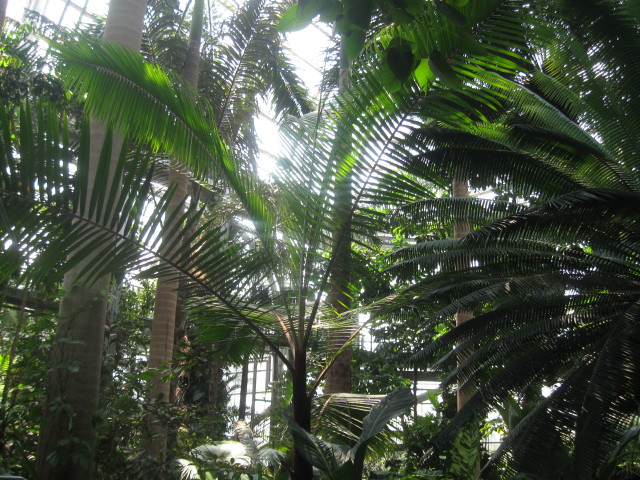
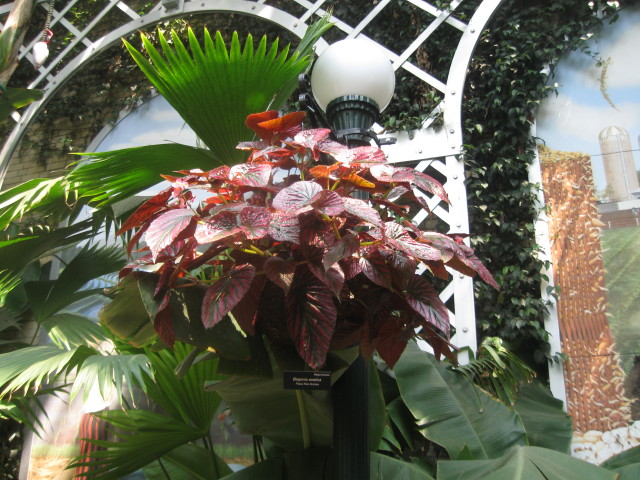
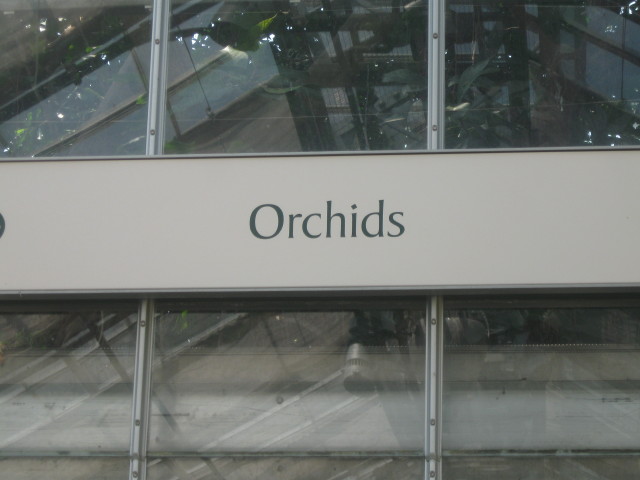
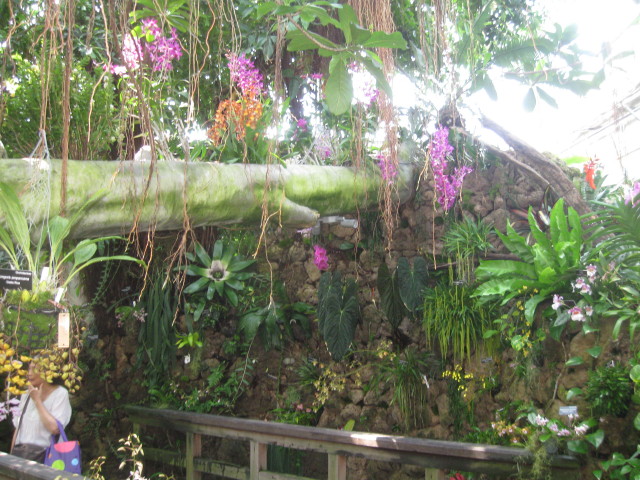
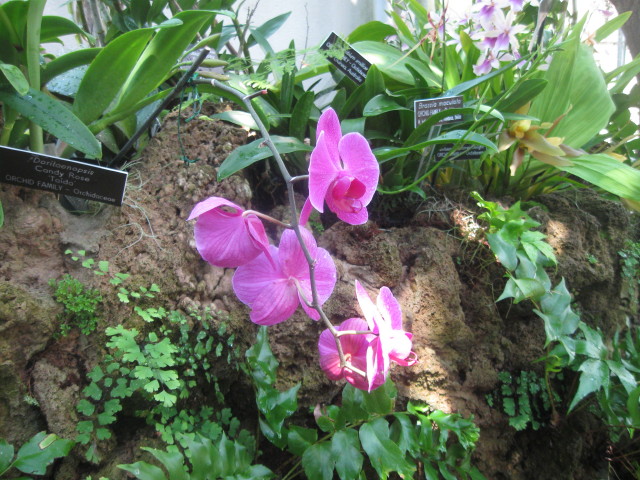
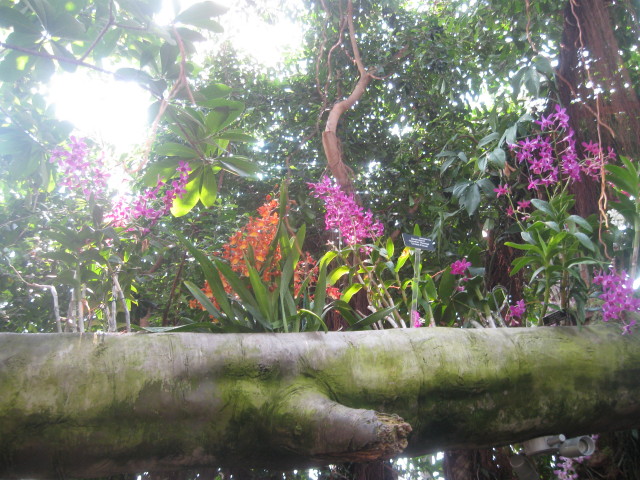
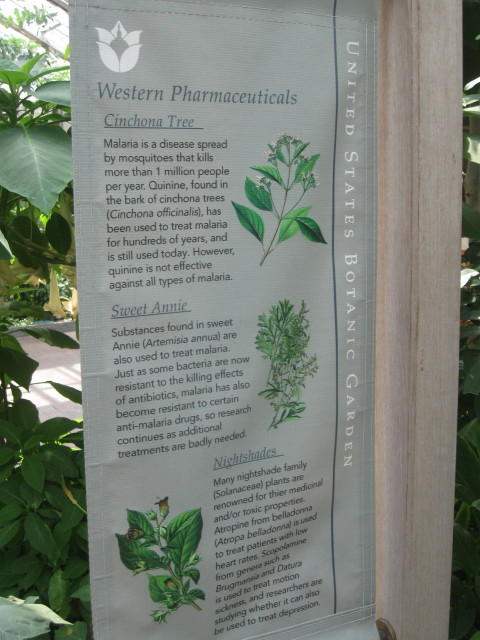

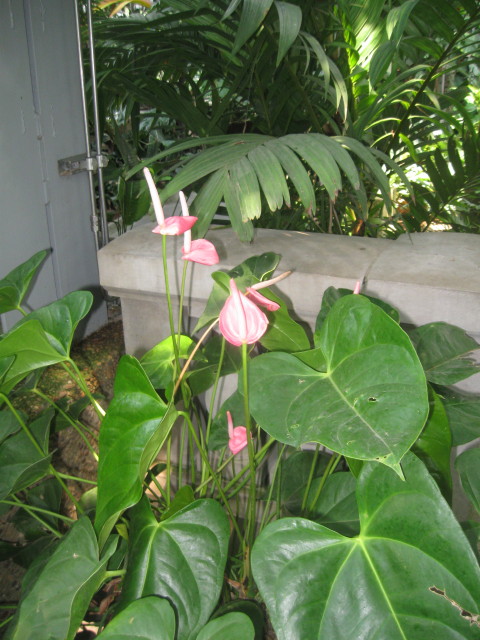
Another place I like to visit
when time permits is Bartholdi Park which is directly across
Independence Ave. S.W. from the United States Botanic Garden
Conservatory. This two acre demonstration garden showcases
innovative plant combinations in a variety of styles and design
themes. The plantings, at their peak of color and lushness
during the summer months, are constantly updated to spotlight
new varieties, design trends and garden maintenance.
The Fountain of Light and Water is the park's
lovely highlight. It is also called the Bartholdi Fountain in
honor of Frederic Auguste Bartholdi, the French sculptor famous
for designing the Statue of Liberty; he created the historic,
black cast-iron fountain standing at its center for the 1876
Centennial Exposition in Philadelphia. Energy-efficient globe
lights come on at sunset, illuminating the fountain and casting
a soft glow.
After finishing my tour I
exited the Conservatory and saw the West side of the Capital.
From here I passed the National Museum of the American Indian
and continued walking down Jefferson Dr. beside the Mall.
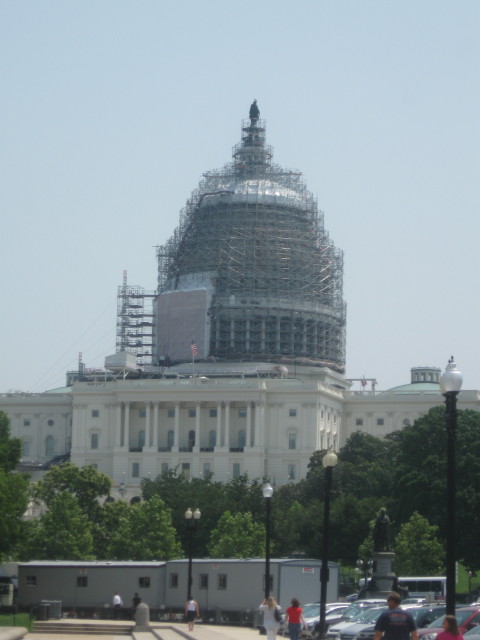
West side of Capital where the inaugurations are held overlooking
the Mall.
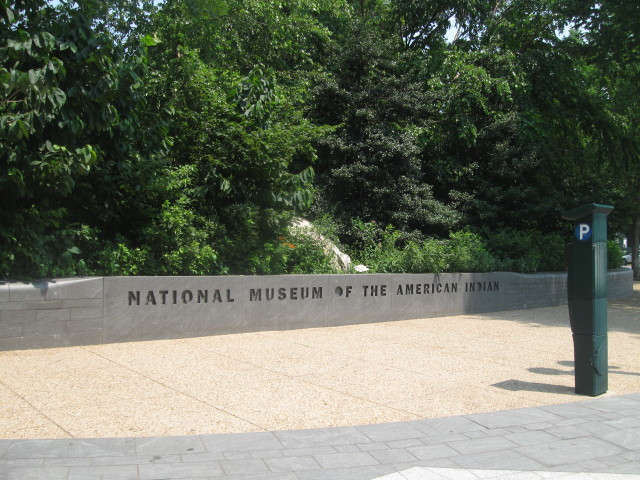
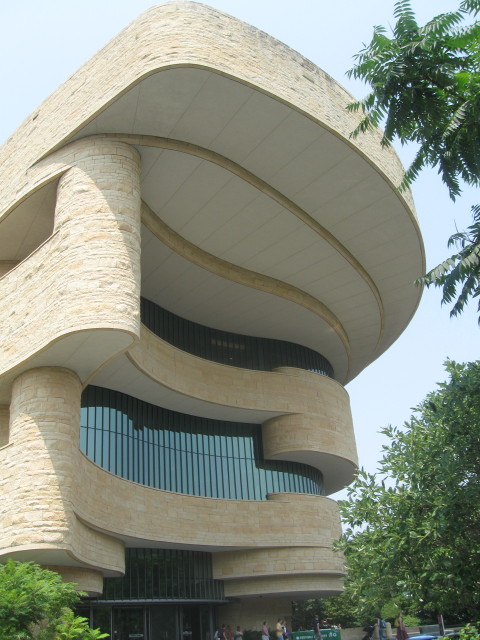
National Museum of the
American Indian is on the National Mall at 4th St. and
Independence Ave. S.W. between the National Air and Space Museum
and the United States Botanic Garden. This Smithsonian museum is
one of three facilities - the others are in New York and
Maryland - presenting the art, customs and history of the
Western Hemisphere's Native people.
The curvilinear building of Kasota
buff-colored limestone simulates natural rock formations
sculpted over time by wind and water. Design features such as a
prism window to mark the solstices and an entrance facing east
toward the morning sun are representative on Native cultures.
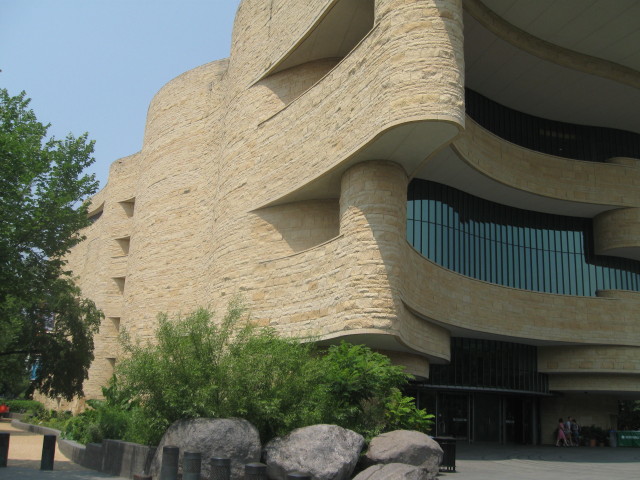
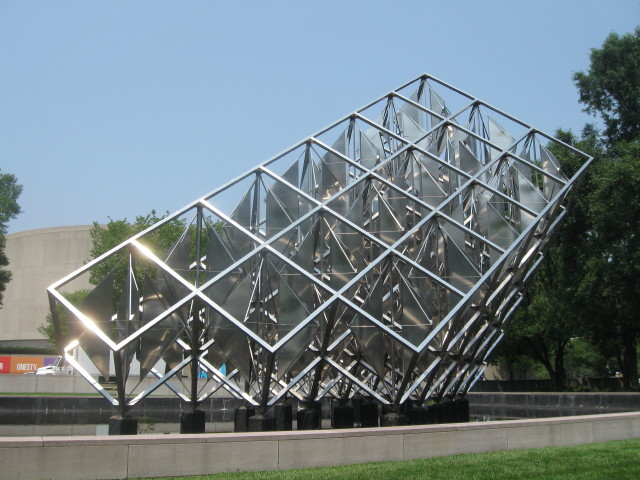
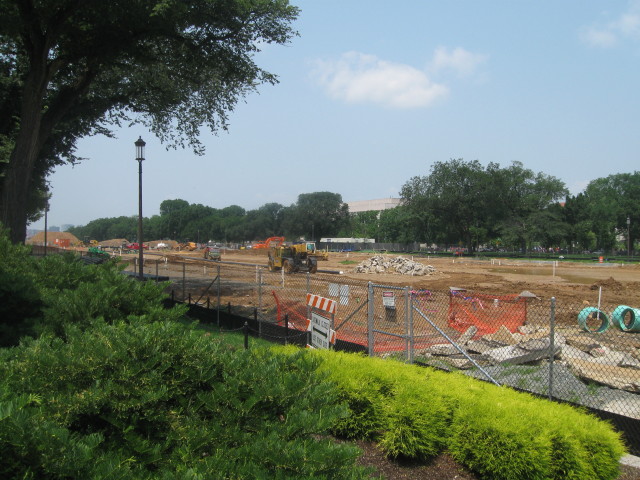
The Mall as I have never seen it.
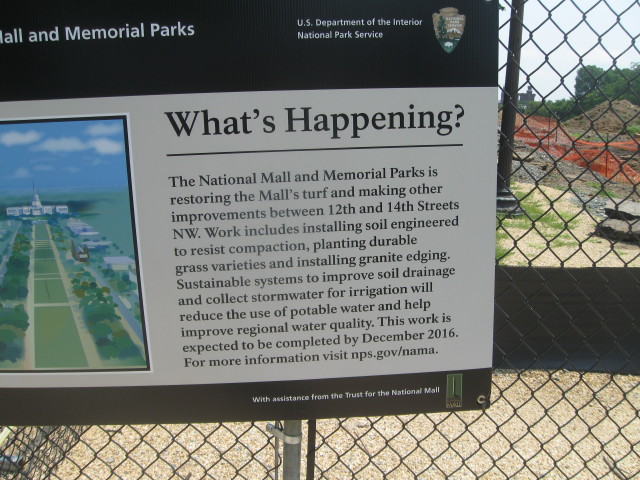
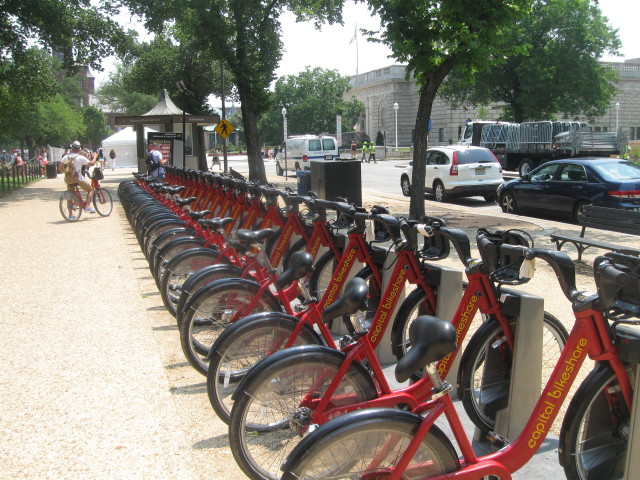
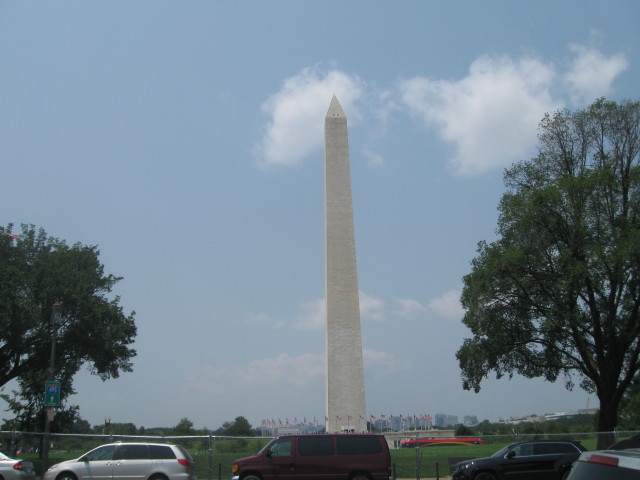
Taken from 14th Street.
The Washington Monument
grounds divide the Mall into two distinct sections. To the east
are the United States Capitol, the United States Botanic Garden
and Smithsonian museums. To the west are the Lincoln, Vietnam,
Korean War Veterans and World War II memorials,
Constitution Gardens and the Reflecting Pool. The distance
between the steps of the Lincoln Memorial and the Capitol
building is approximately 2 miles. The Mall is the dividing line
between D.C.'s Northwest and Southwest quadrants and is divided
into two separate sections by 14th Street.
This was my destination as my next stop was
across the corner, a stop I always try to make on every visit to
the District. After my first visit I was hooked.
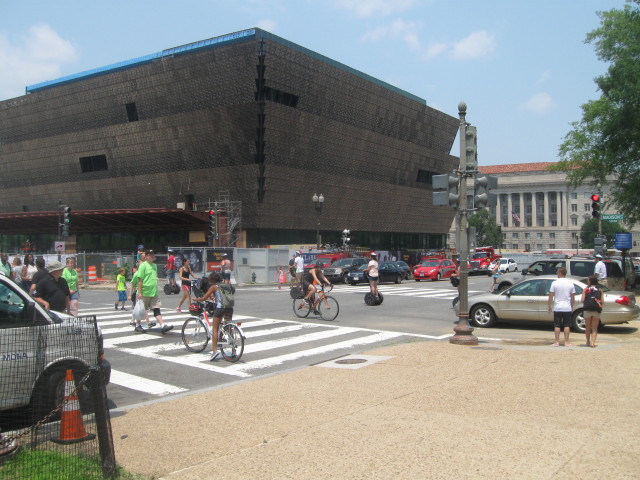
New museum under construction.
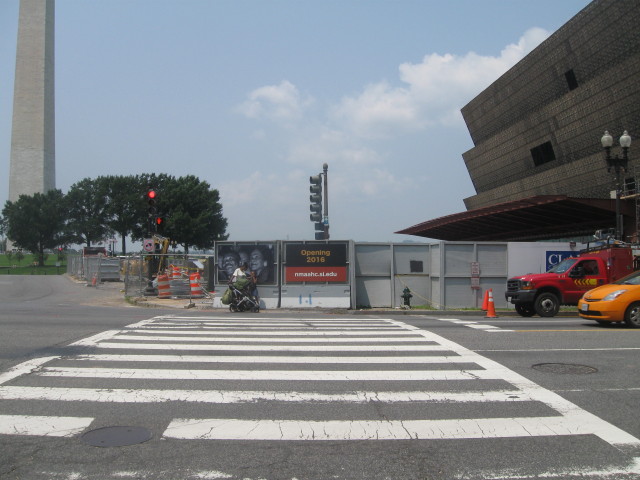
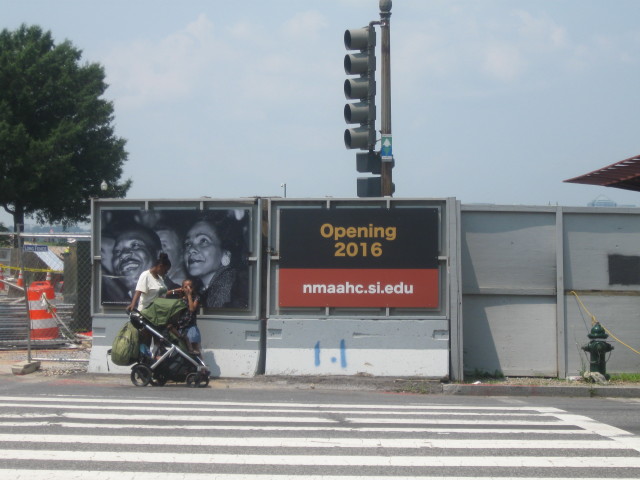
National Museum of African American History & Culture.
National Museum of American
History is on Constitution Ave. between 12th and 14sts. N.W. It
presents the cultural, social, technological and political
development of the United States.
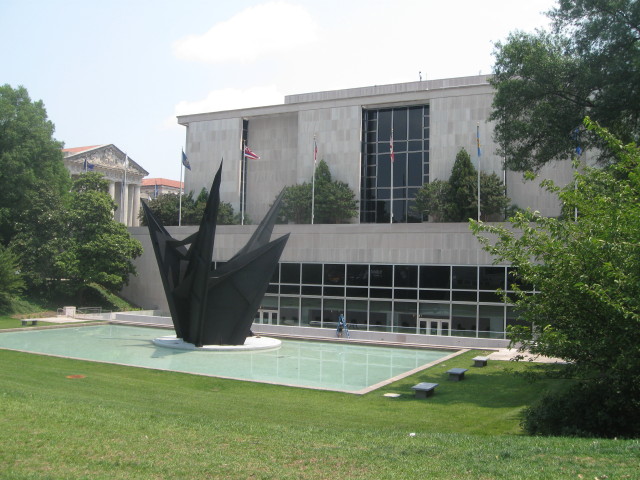
Ground floor windows are the
location of the museum's cafeteria, Stars & Stripes Cafe
where I like to eat when in this part of the city.
Going thru security was easy and I then went all over to see old
standbys and the new additions.
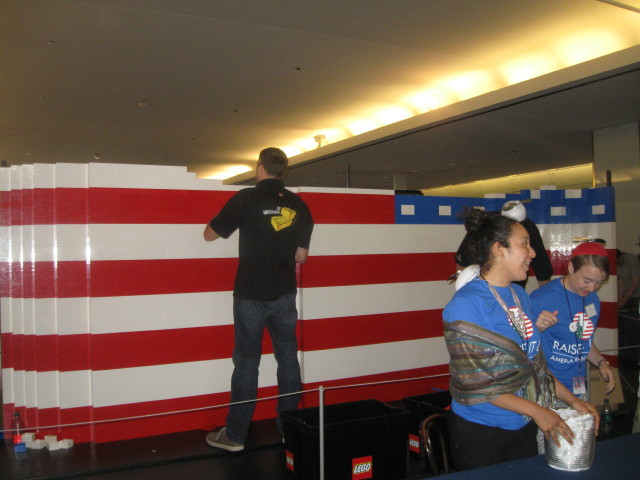
Building a Lego flag.
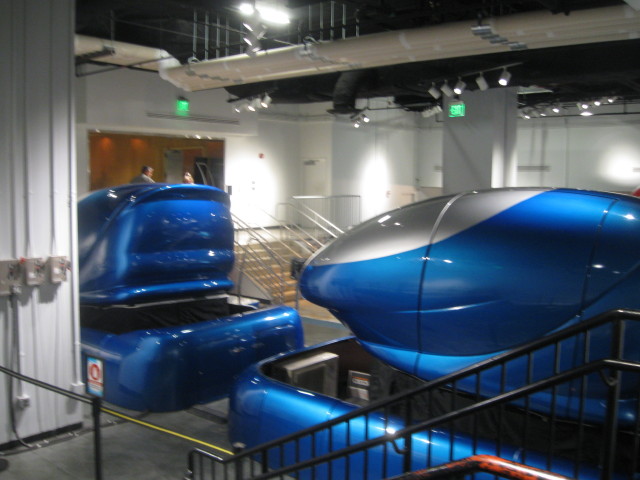
Simulators for pay and play.
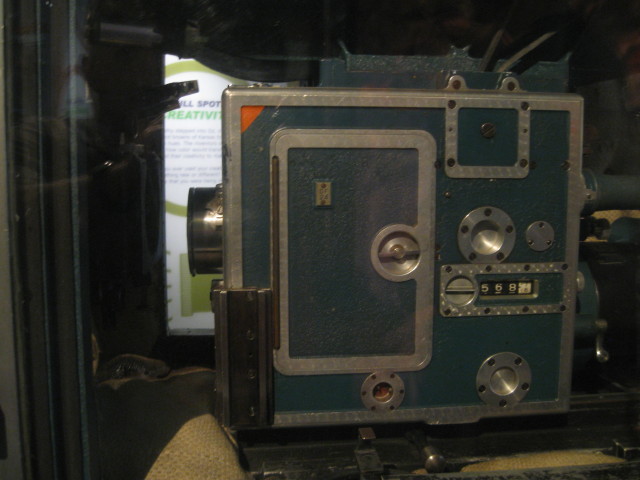
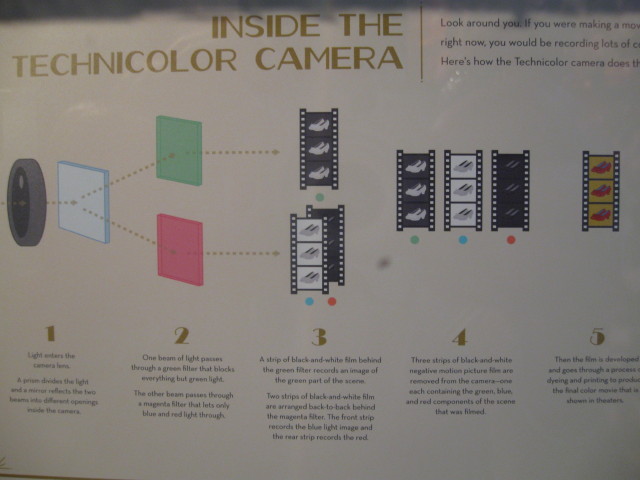
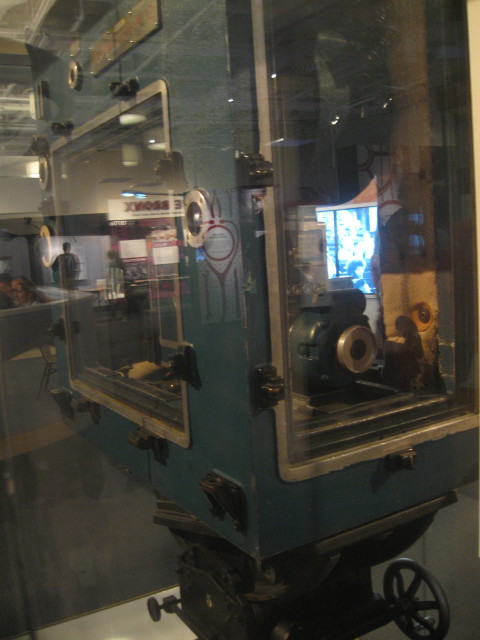
It was getting close to 1 pm
and I was ready for lunch so I went downstairs to the Stars
& Stripes Cafe and dined on a BBQ Pulled Pork sandwich with
a drink. Afterwards, with a full tummy I was ready to explore
America's Attic.
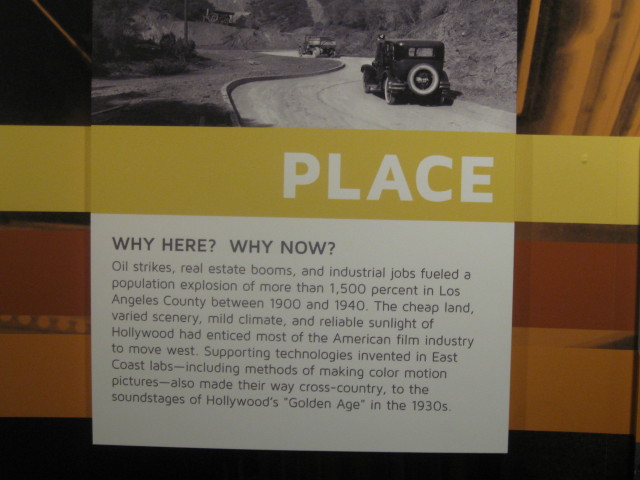
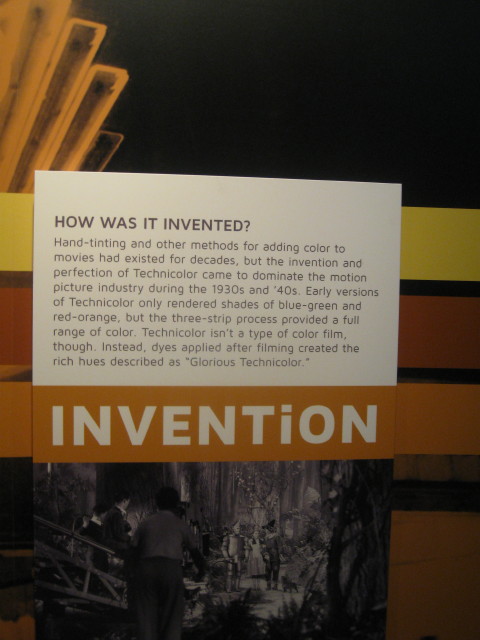
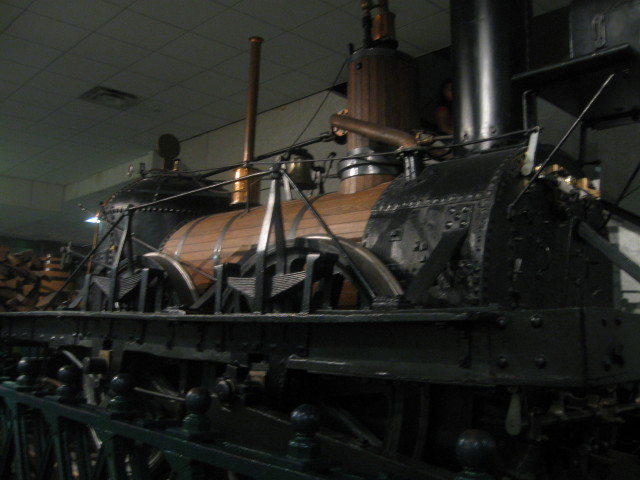
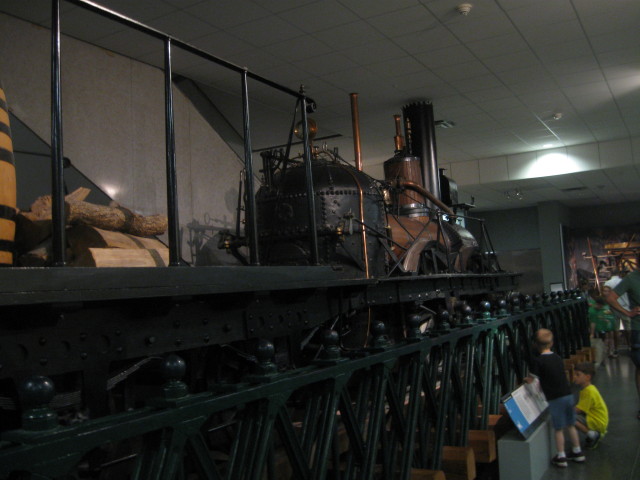
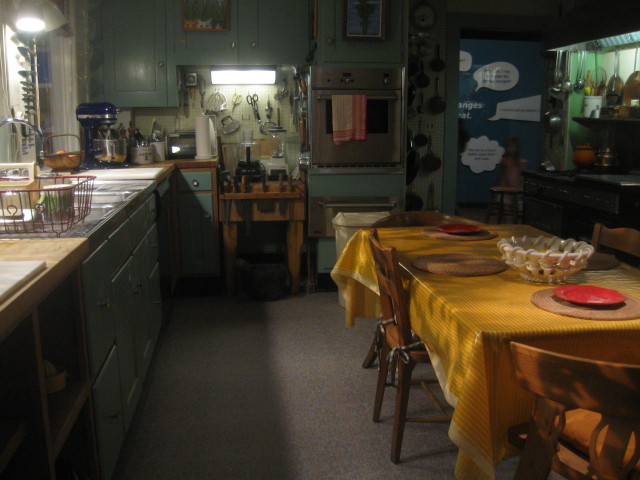
FOOD: Transforming the
American Table 1950-2000 offers visitors a look at the stage
where one of the world's best-known cooks worked her culinary
magic; "French Chef" Julia Child donated the kitchen from her
Cambridge, Massachusetts home to the museum.
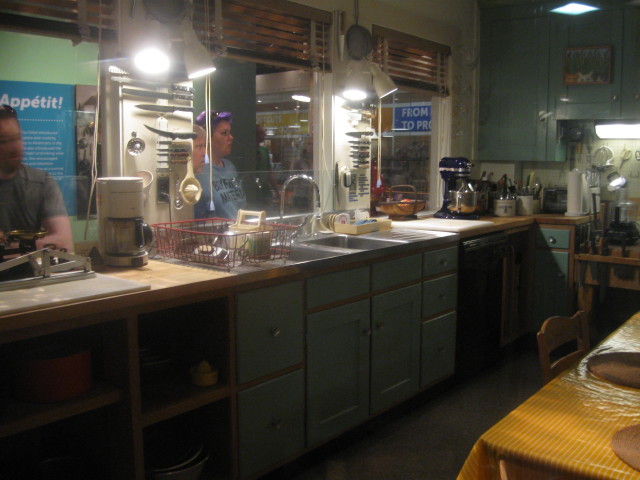
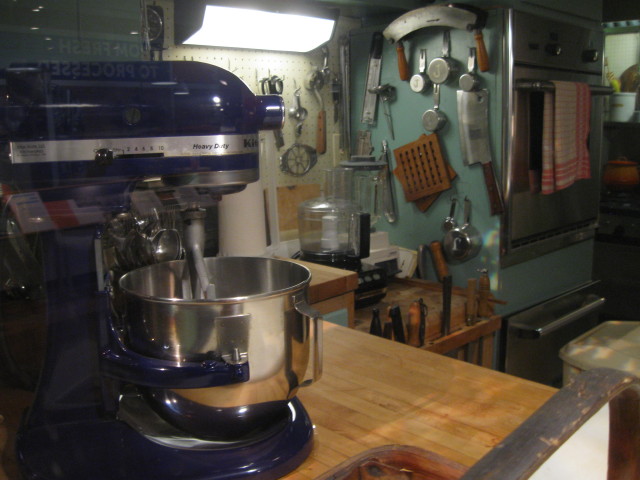
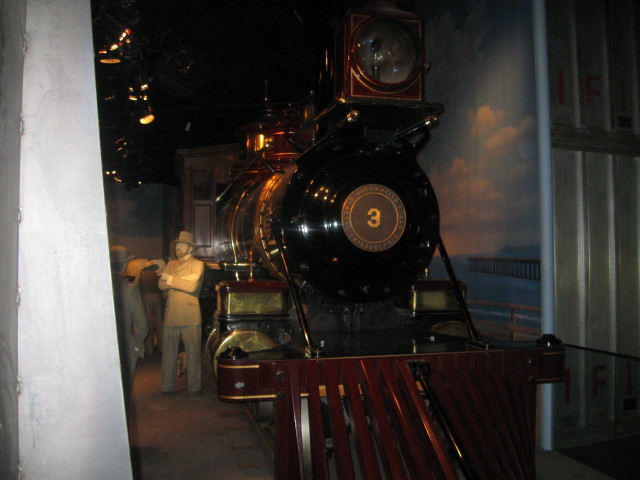
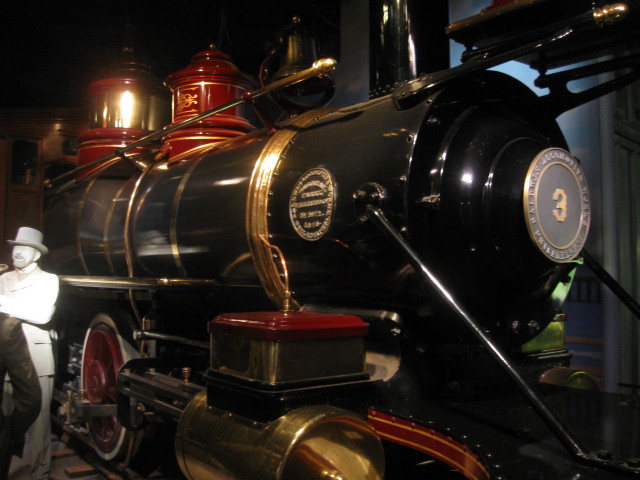
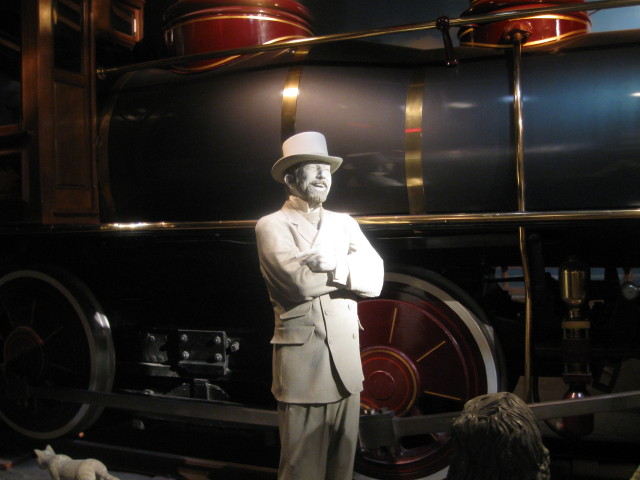
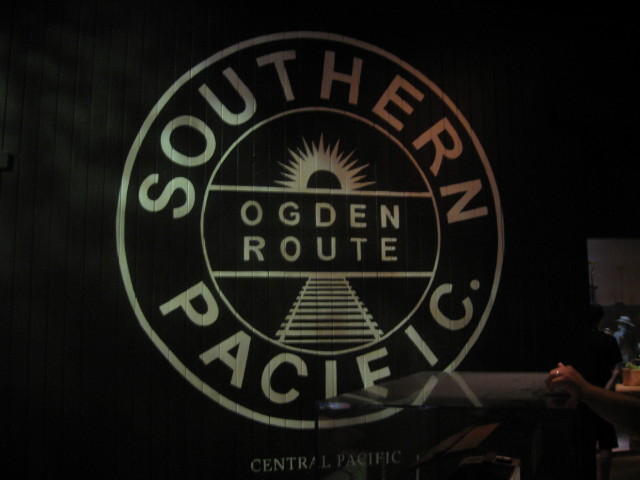
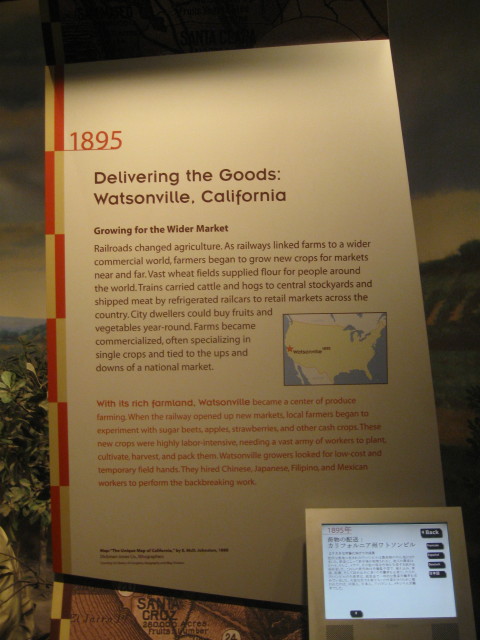
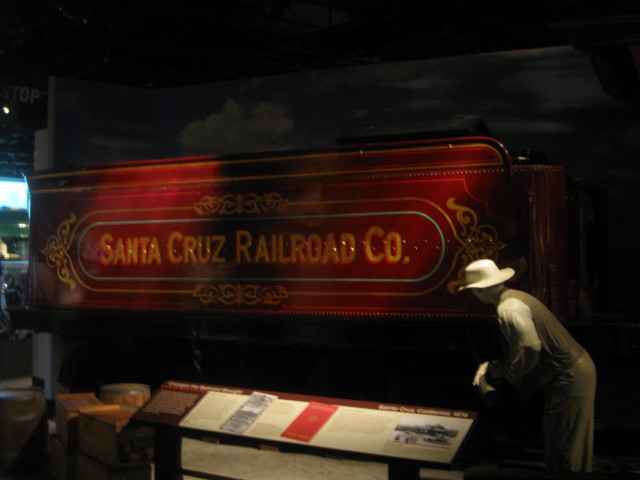
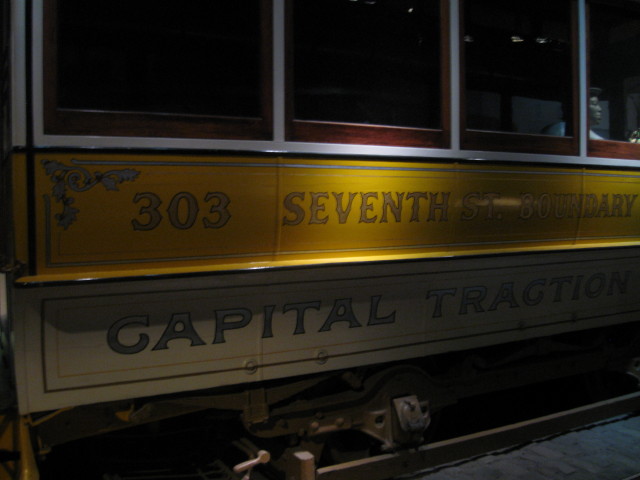
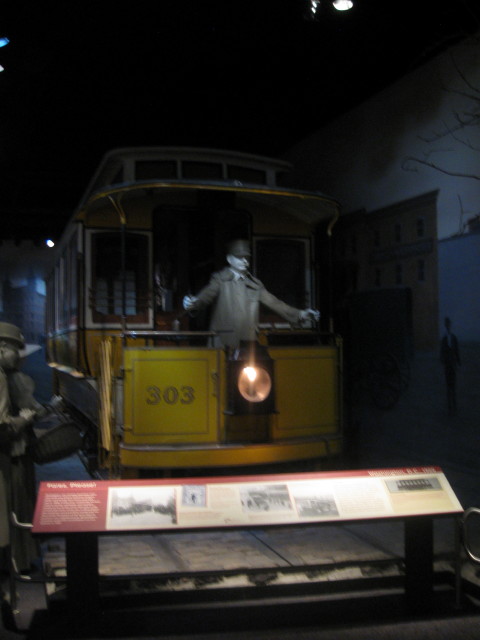
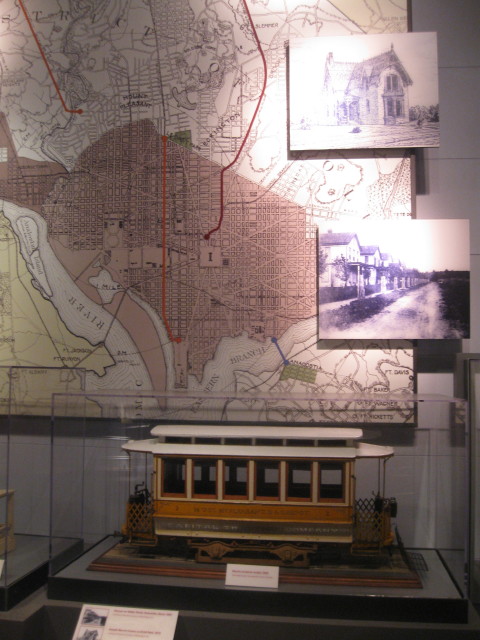
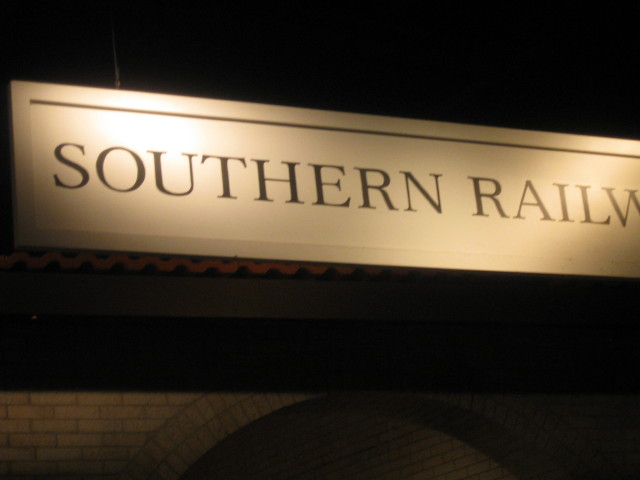
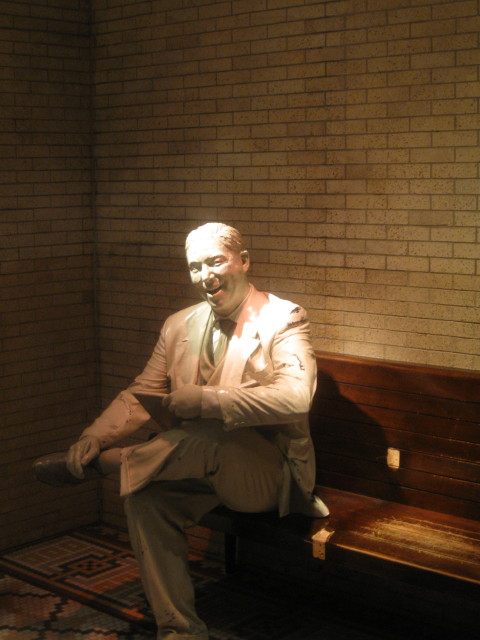
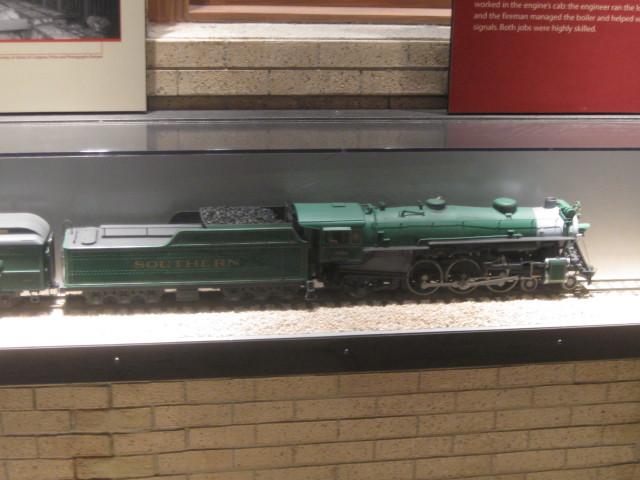
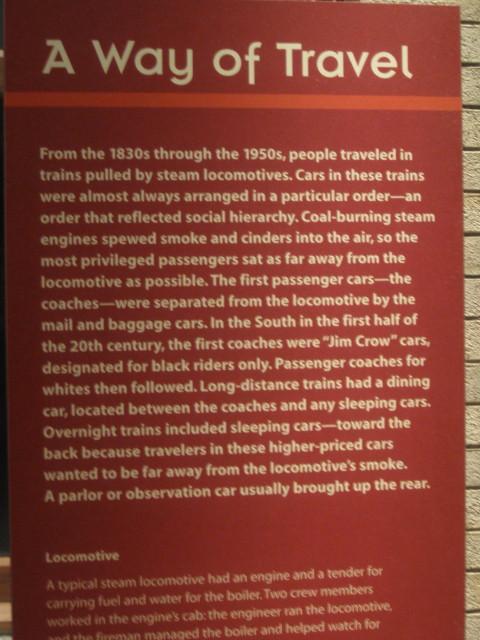
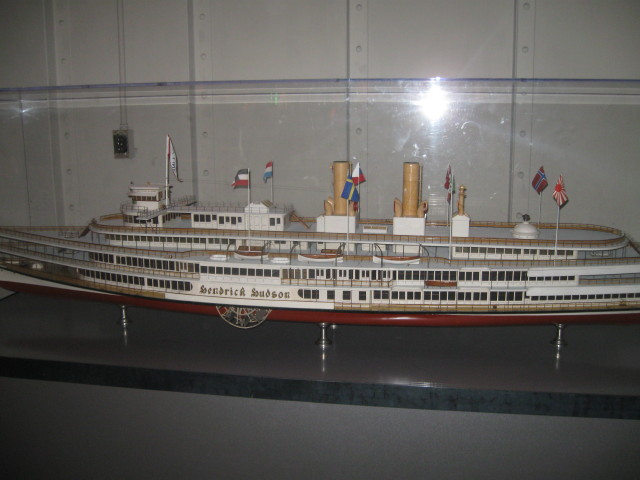
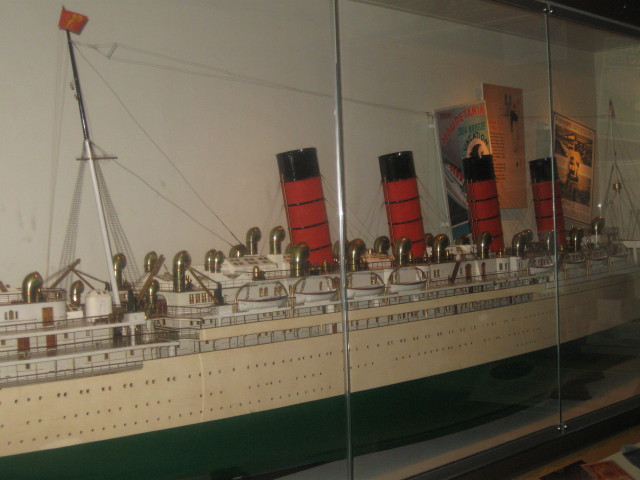
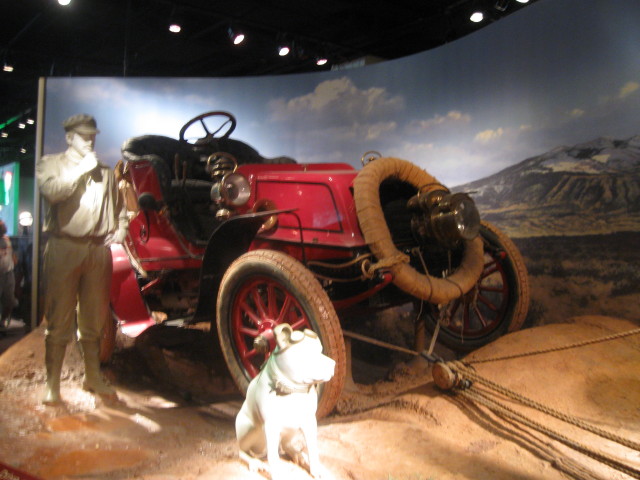
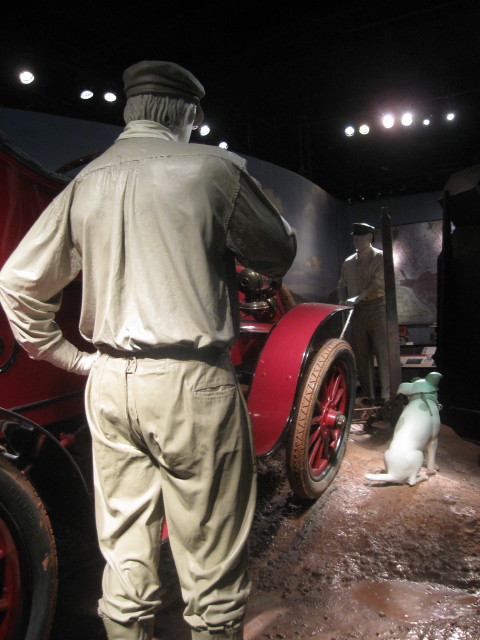
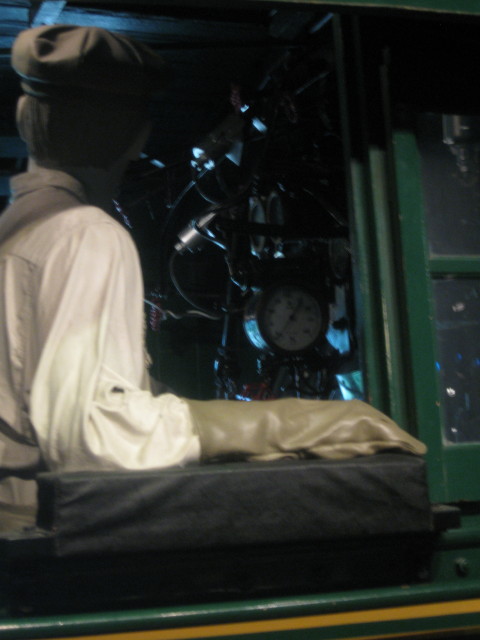
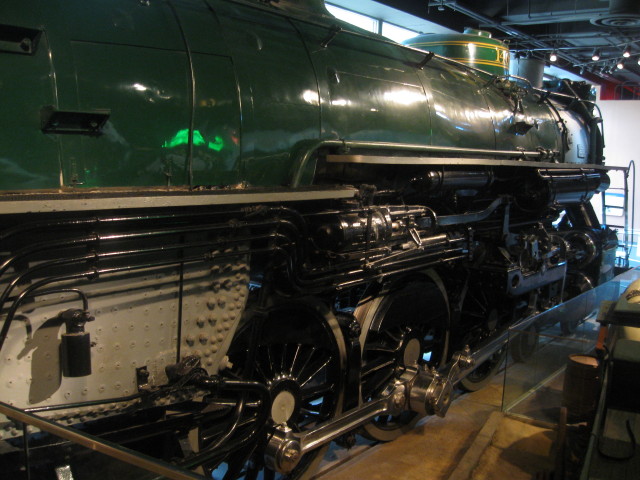
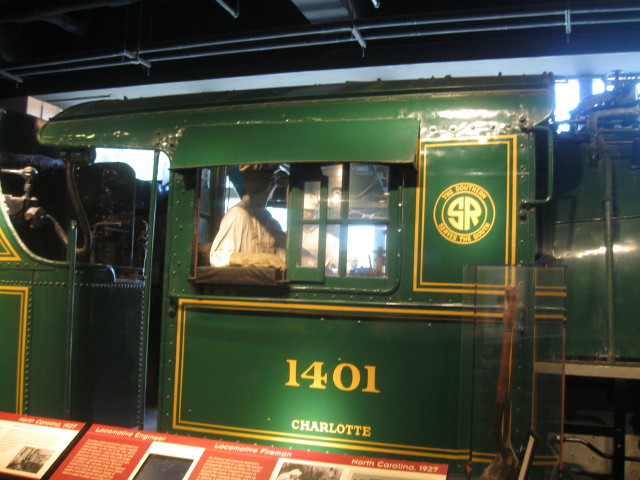
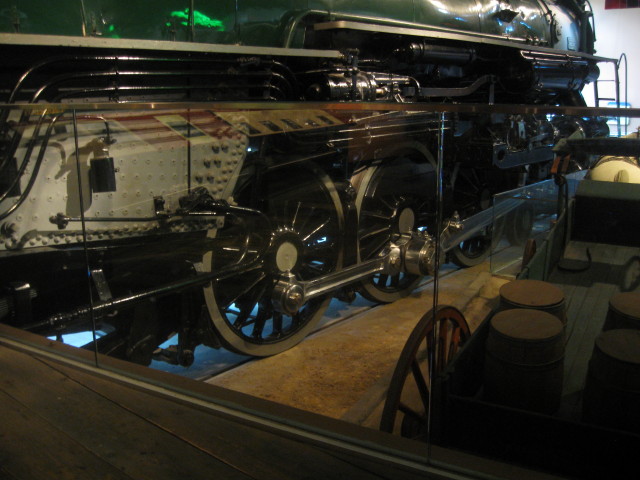
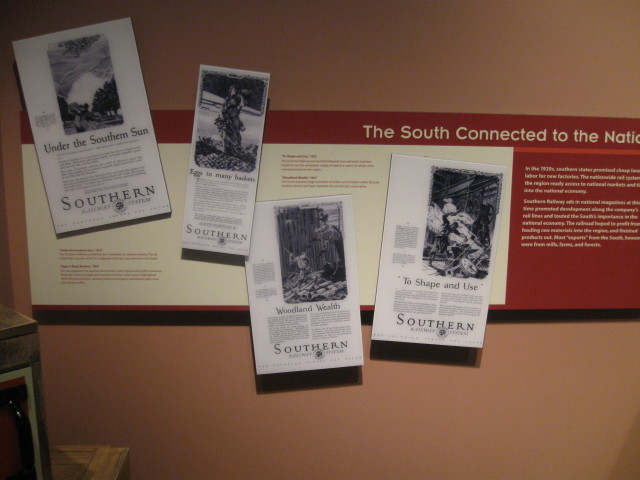
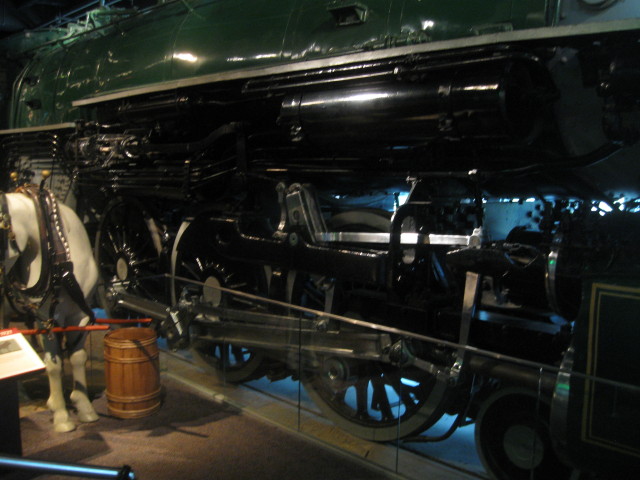
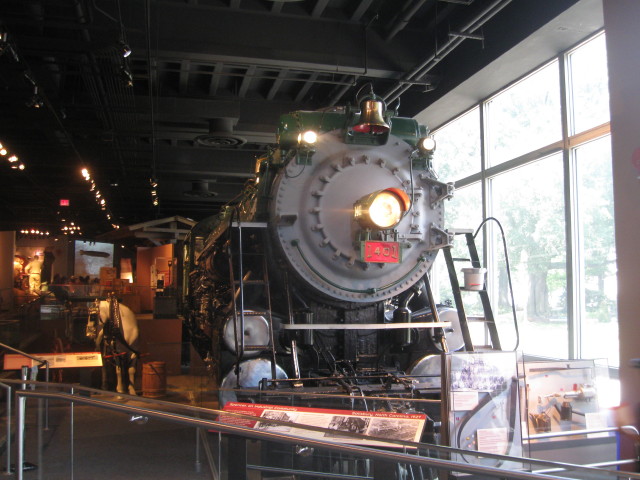
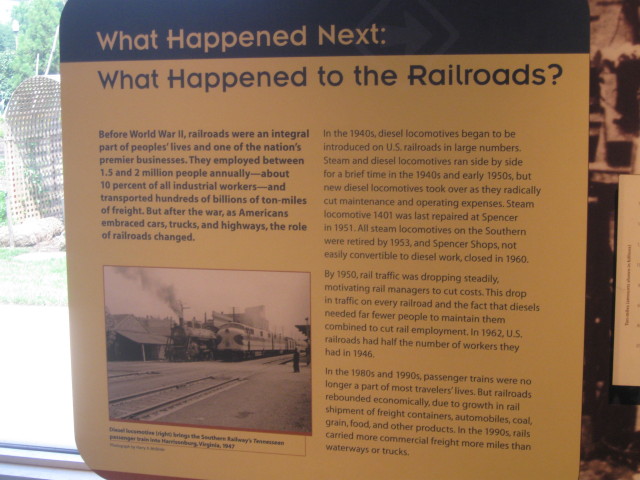
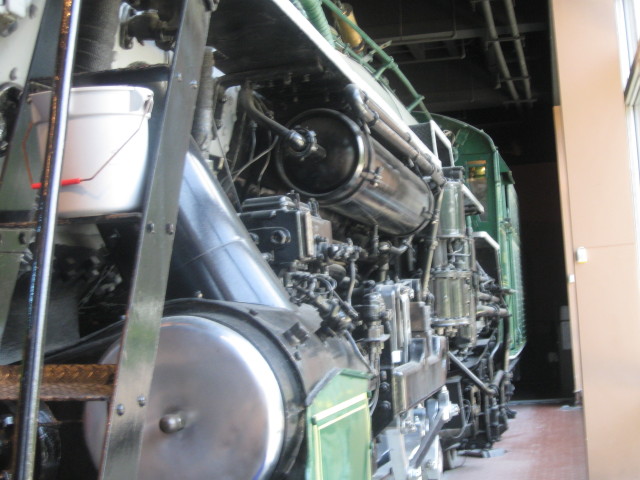
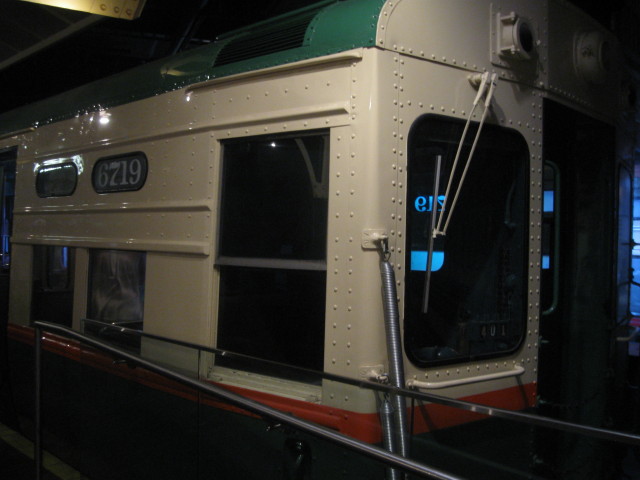
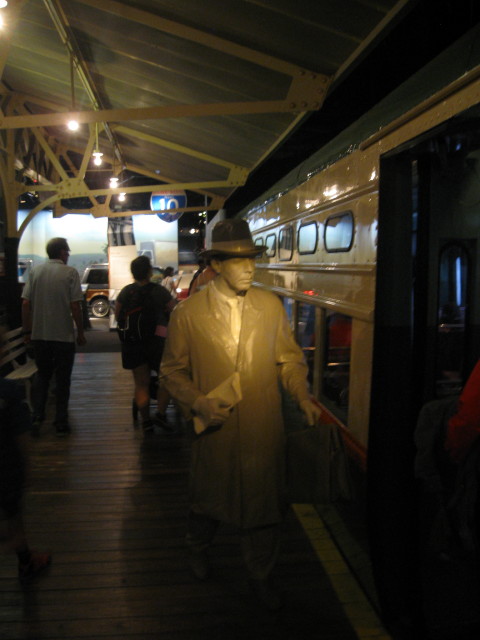
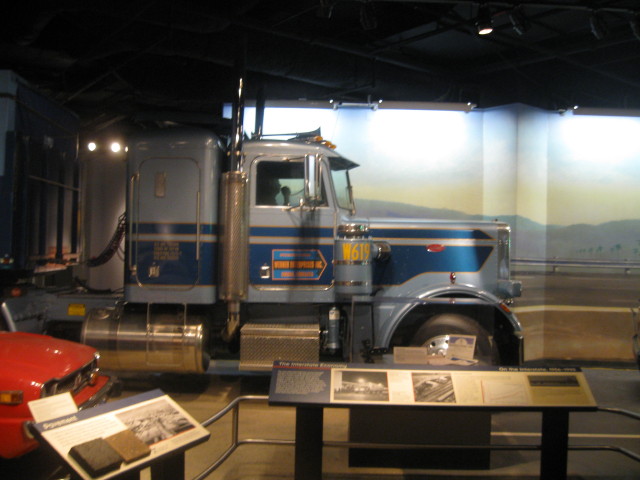
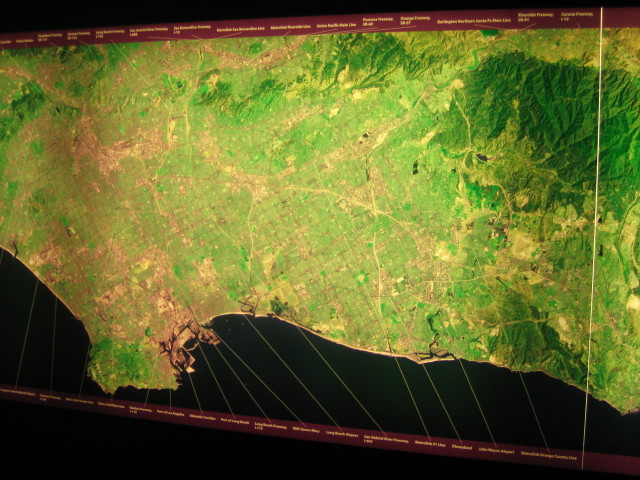
Los Angeles and Long Beach ports are located in lower left. My
home is about 3 inches from the water in center of picture.
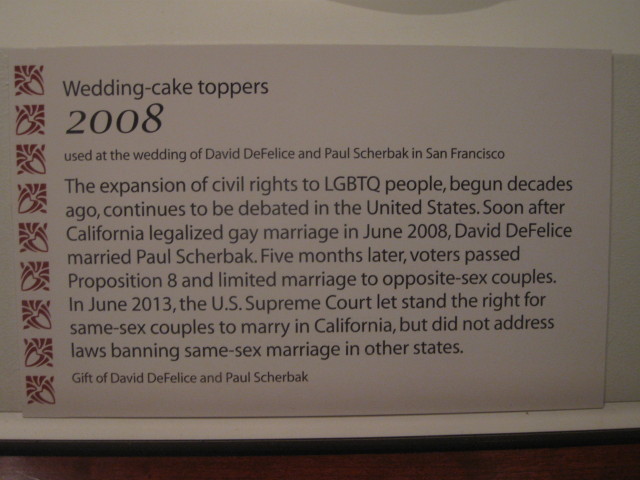
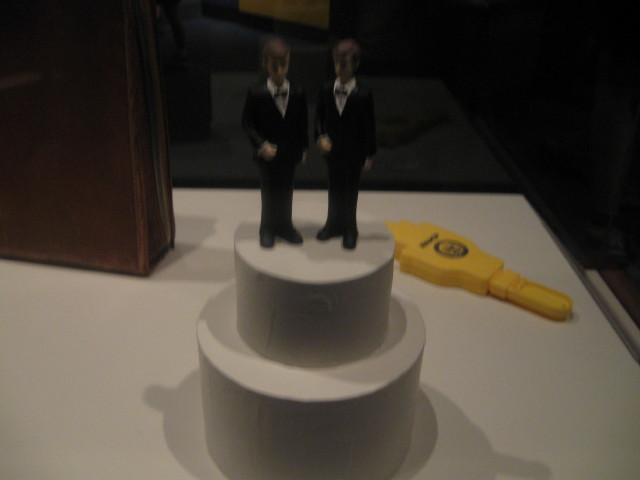
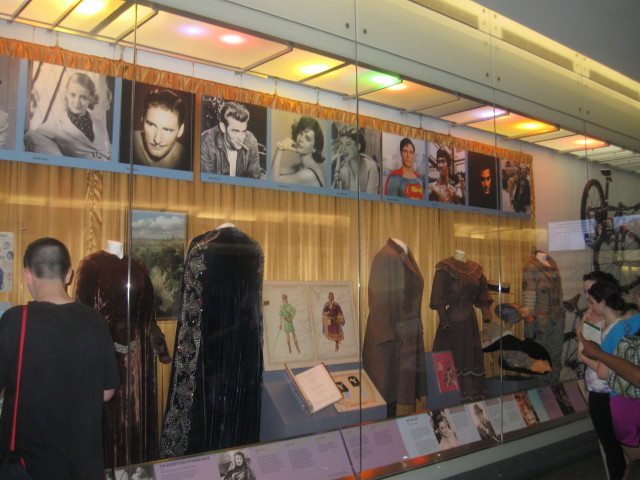
These glass-fronted cases are filled with rotating displays that
highlight objects and new acquisitions from the museum's vast
collections.
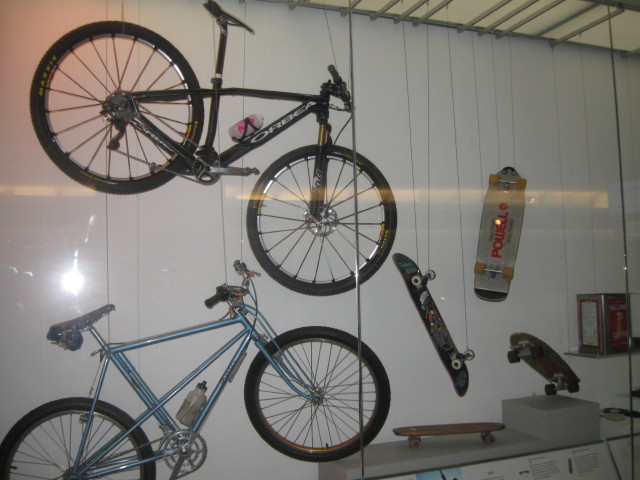
After three hours of looking,
reading and picture taking, it was near 4 pm and I was ready to
move on. Exiting on Constitution Ave. I walked up to 12th St
turned right and headed to Madison Dr. At Madison Dr. NW and
12th St I came across a really great find. It was stop # 4 for a
new bus service called DC Circulator National Mall Service. The
route starts at Union Station goes down the Mall and then over
to the Tidal Basin around the Lincoln Memorial and then return
via the Mall to Union Station. I could have used this service on
past visits and is great for seeing different museums and sites
not located next to each other. They run every ten minutes with
$1.00 fare, Senior: 50 cents. This bus route is a new service
started about three weeks ago. I boarded the next bus, paid my
$.50 and rode to stop # 7 the Thomas Jefferson Memorial. I still
had two hours before being back at Union Station and by using
this bus I received bonus time to visit a place I've only seen
from a far.
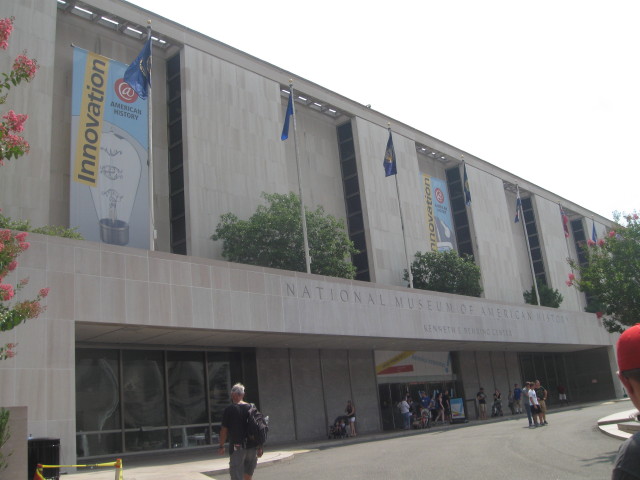
Inside you will find venerable historic items like the
Star-Spangled Banner, a compass used by explorers Lewis and Clark
and Cold War-era submarines, as well as pop culture mementos like
Dorothy's ruby slippers from "The Wizard of Oz." Another highlight
is the collection of first ladies gowns.
Thomas Jefferson Memorial
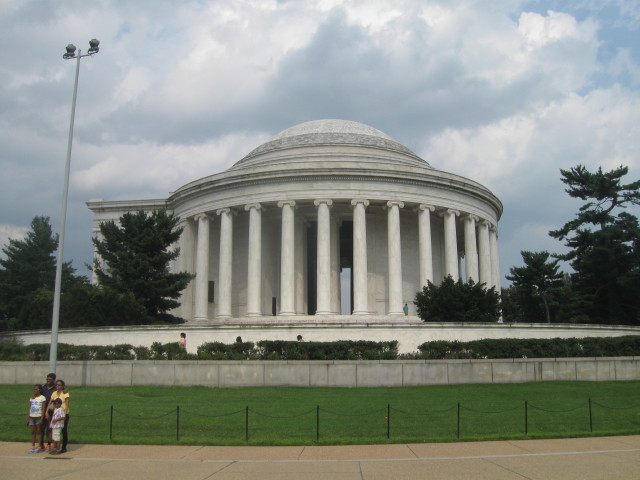
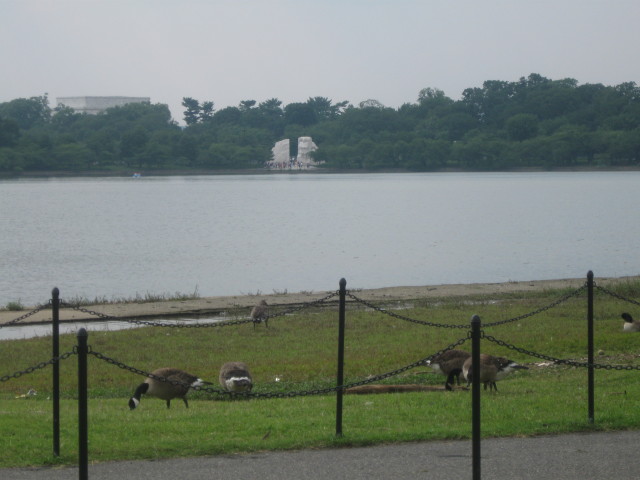
Looking out over the Tidal Basin to the MLK, Jr Memorial.
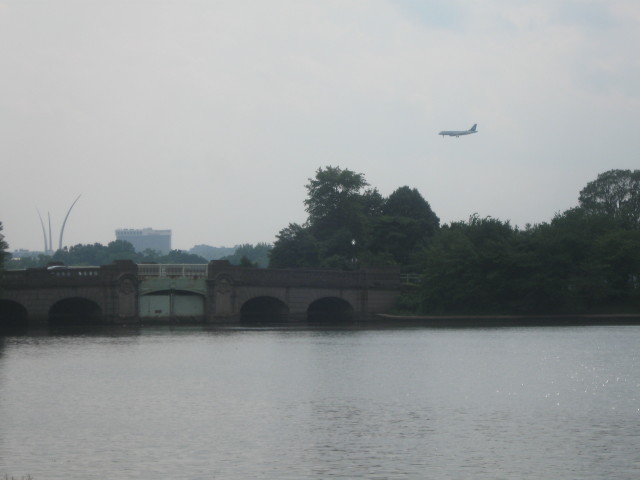
Plane on approach to Washington National Airport.
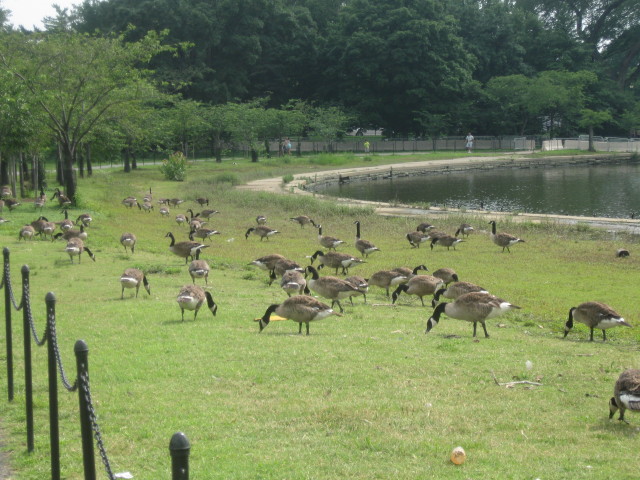
Shoreline of the Tidal Basin.
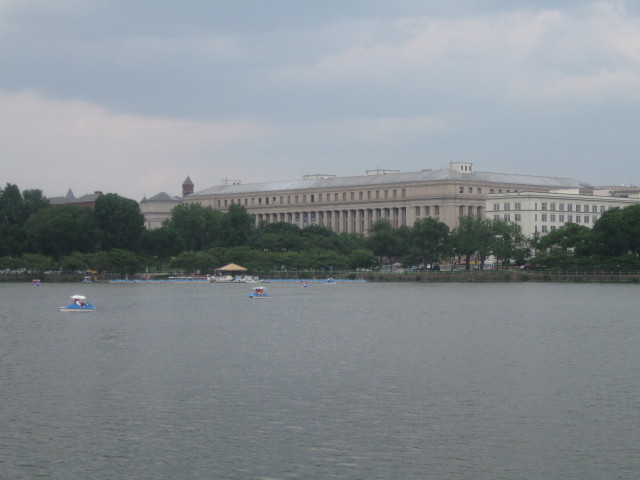
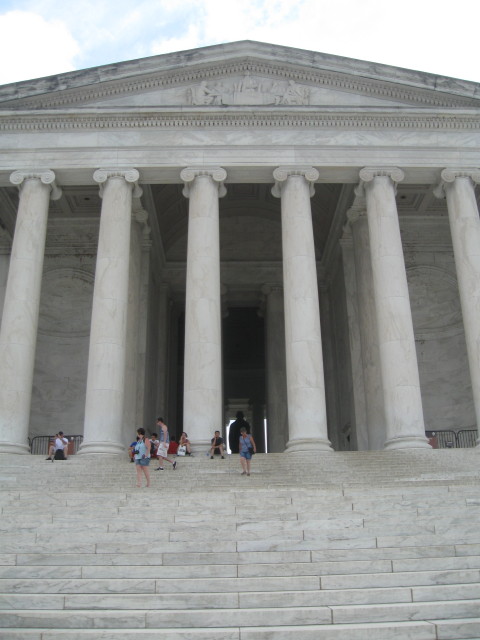
Thomas Jefferson Memorial
stands on s.e. bank of the Tidal Basin. It honors the country's
third president, the author of the Declaration of Independence
and the founder of the University of Virginia. During his two
terms as president, Jefferson negotiated the 1803 Louisiana
Purchase, which nearly doubled the size of the United States,
and sponsored the monumental expedition of Meriwether Lewis and
William Clark to the Pacific Northwest, which paved the way for
19th century westward expansion.
A grand series of steps leads to the portico
the opens into the rotunda, where a circular dome is supported
by Ionic columns. Designed by John Russell Pope, the memorial
was modeled on the Pantheon in Rome. The focal point of the
interior space is Rudolph Evans' 19-foot-tall bronze statue of
Jefferson, clad in a long, open coat over a button-down vest.
Panels on the white marble walls are inscribed with some of most
significant writings.
In November 1939 President Franklin D.
Roosevelt laid the cornerstone for the memorial, and he
dedicated it on Apr. 13, 1943, the 200th anniversary of
Jefferson's birth. A plaster model of the statesman's
likeness stood in place of the bronze statue until metal
restrictions were lifted after World War II. The memorial's
beauty is enhanced in late March or early April, when the
Yoshino cherry trees lining the Tidal Basin are swathed in
clouds of pale pink blossoms; during these few days there may be
no lovelier spot.
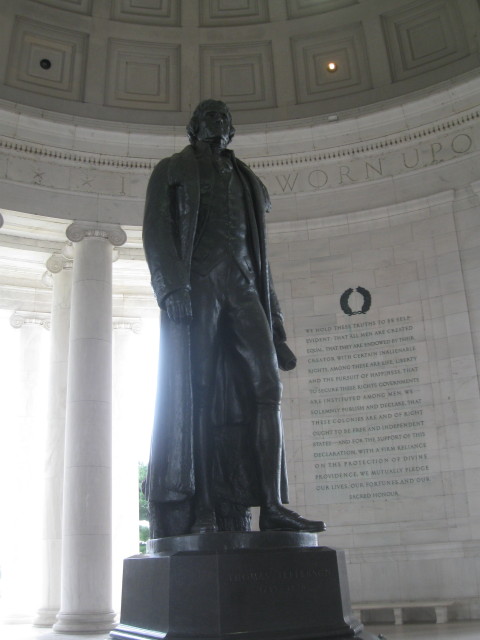
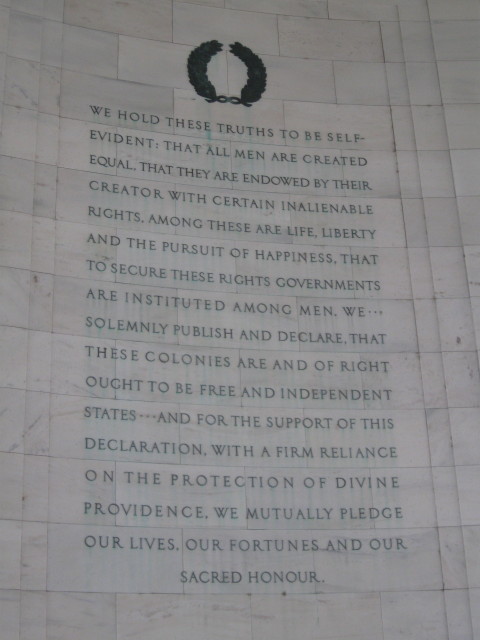
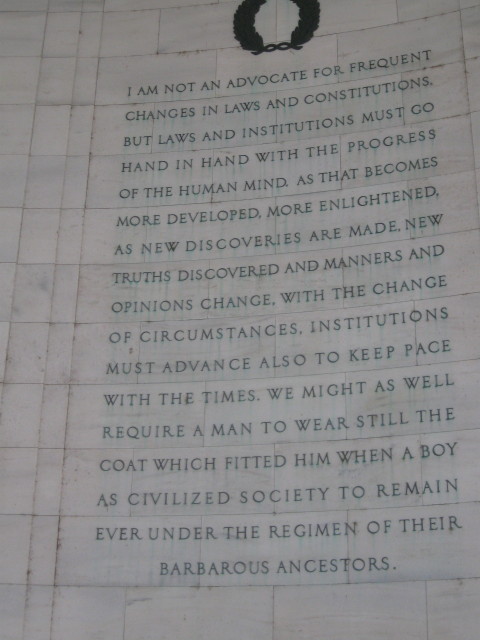
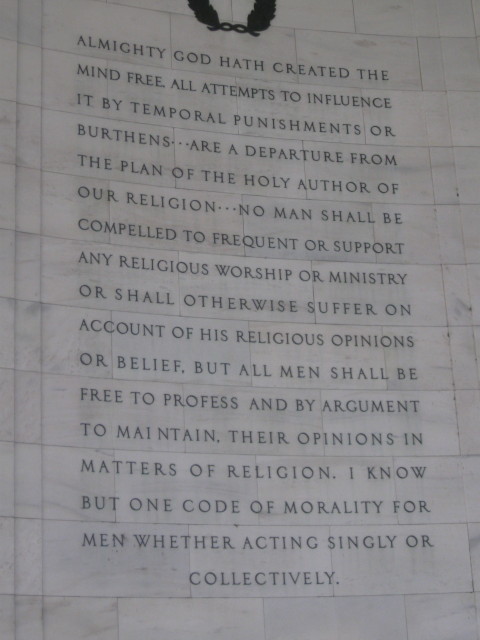
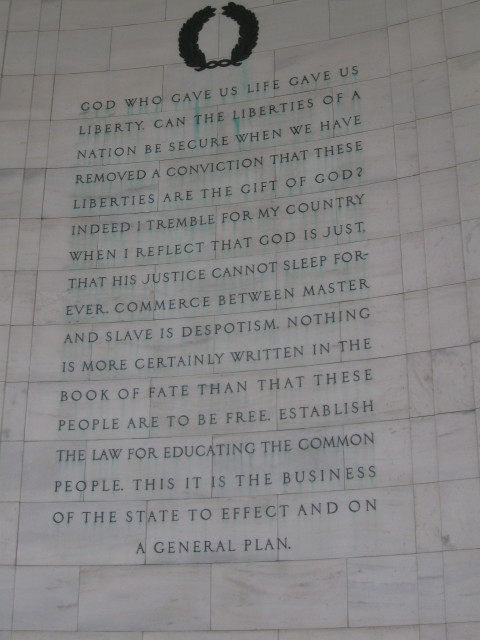
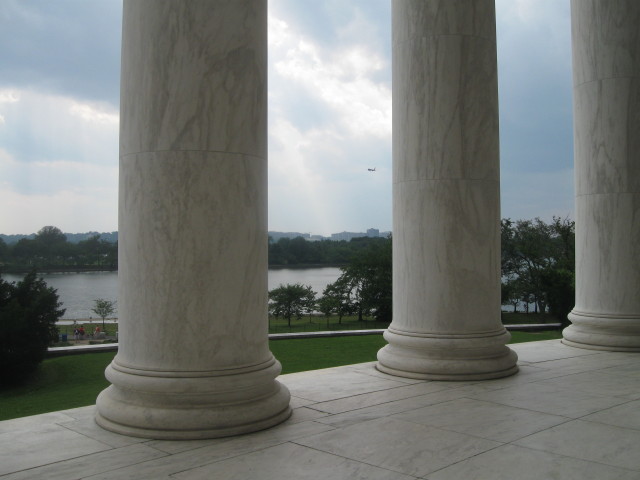
Potomac River.
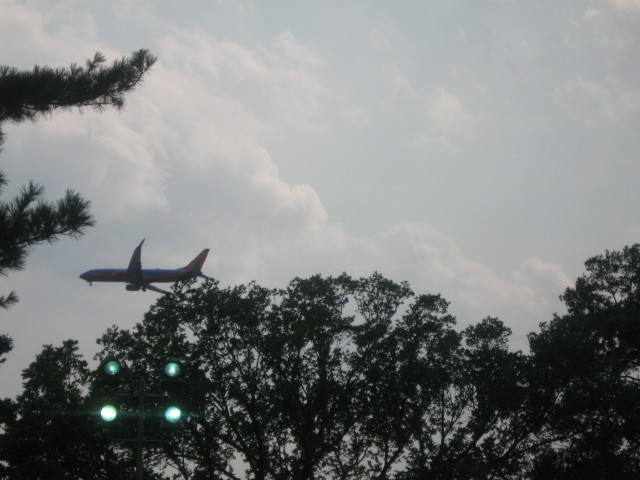
Airport is close by.
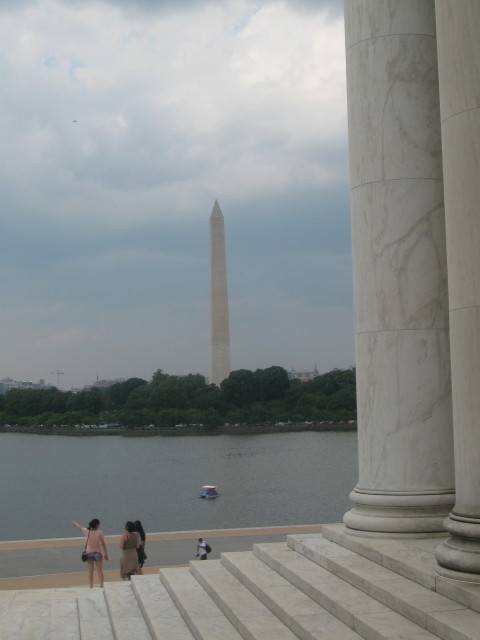
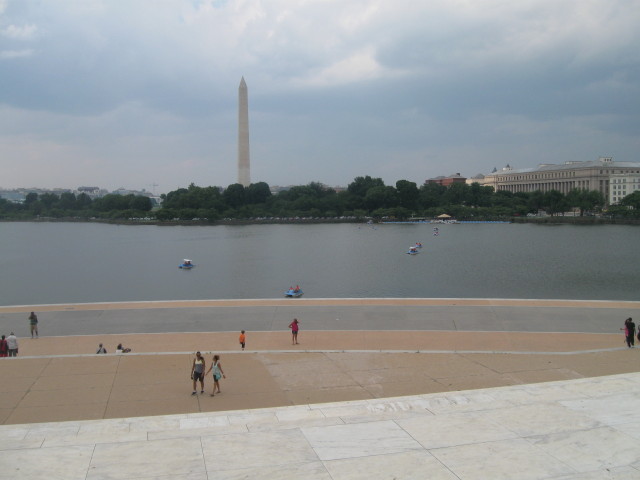
Water fun on the Tidal Basin.
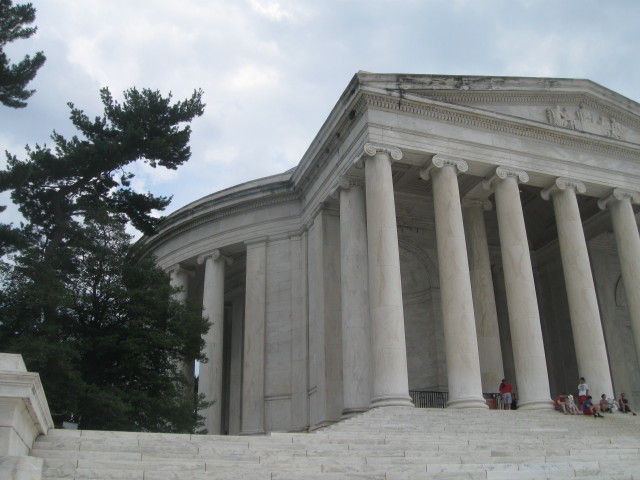
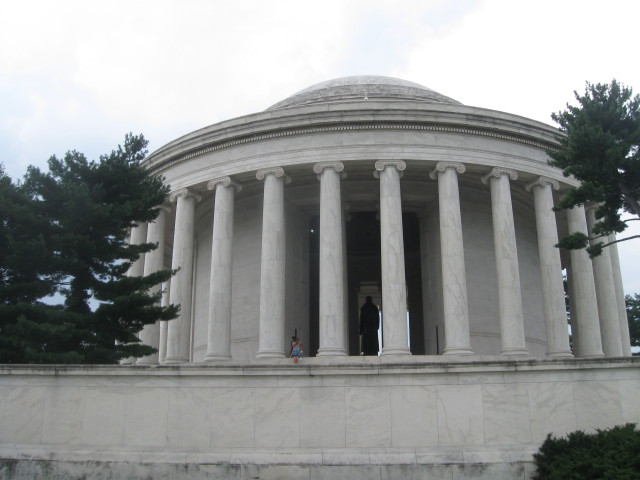
After about one hour I took
the next bus back to Union Station. The bus went on Ohio Dr.
along the Potomac to the next stop # 8; the Martin Luther King,
Jr. Memorial/ Franklin Delano Roosevelt Memorial.
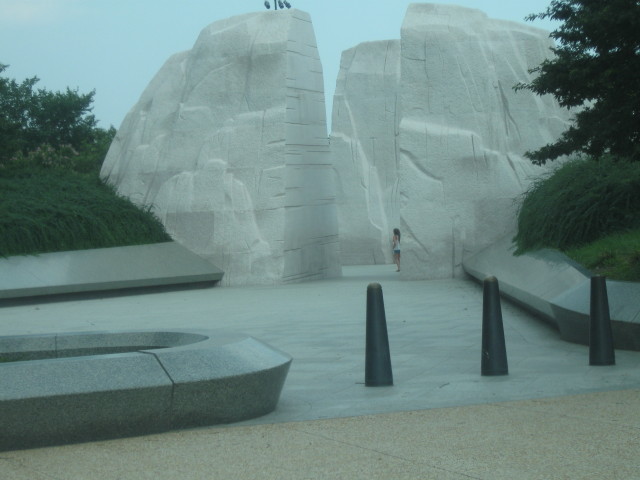
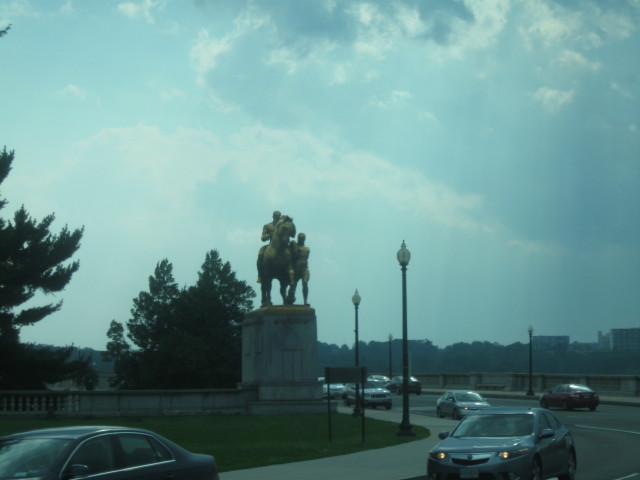
We pass the Arlington Memorial Bridge and then stop # 9 at Lincoln
Memorial.
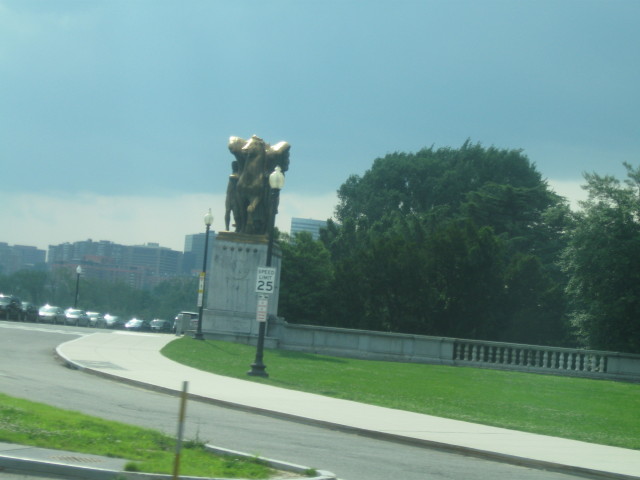
After turning on to
Constitution Ave. we hit big city rush hour traffic where it
doesn't move in either direction. The minutes were steadily
getting closer to 6 pm but we were not getting closer to Union
Station. Now I was getting worried about being late. Plan A stay
on bus. Plan B get off and walk. Walking should take 30 minutes.
Will the bus get there in under 30 minutes? I opted for the bus
and hoped the traffic would break up soon so I could arrive on
schedule.
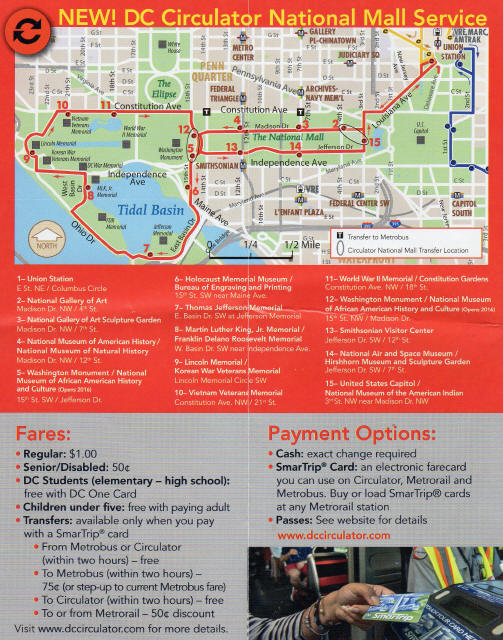
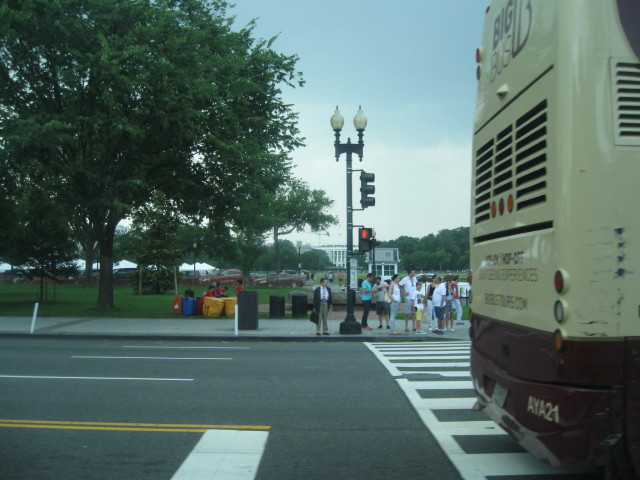
View from Constitution Ave of The Ellipse and the White House.
We turned down 15th St and
then turned again to go up Jefferson Dr. toward the Capital
and then Louisiana Ave to Union Station and the walk across
Columbus Circle to the station. After arriving I proceeded to
the Amtrak counter and found out that my train was over
two hours LATE. Well that was a unnecessary worry about
getting back on time. Lesson: Call Julie and get up-to-date
information on your train status and save some worry.
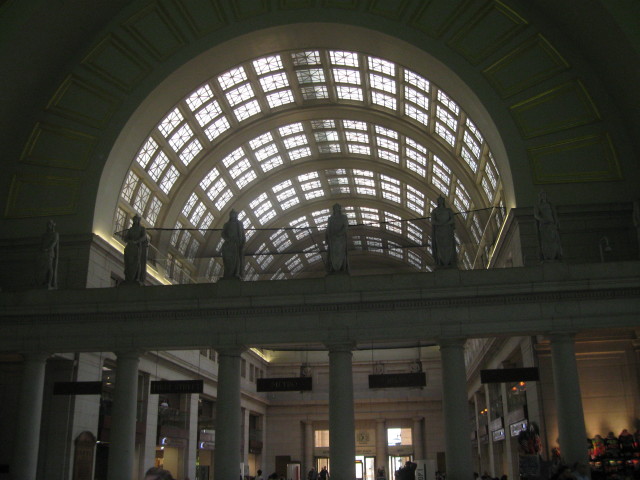
Now with extra wait time I
roamed the station and went into several shops. I stopped in a
liquor store and bought a fine bottle of rum and six-pack of
Pepsi for a night cap later in my room and maybe a cocktail
tomorrow while riding the rails.
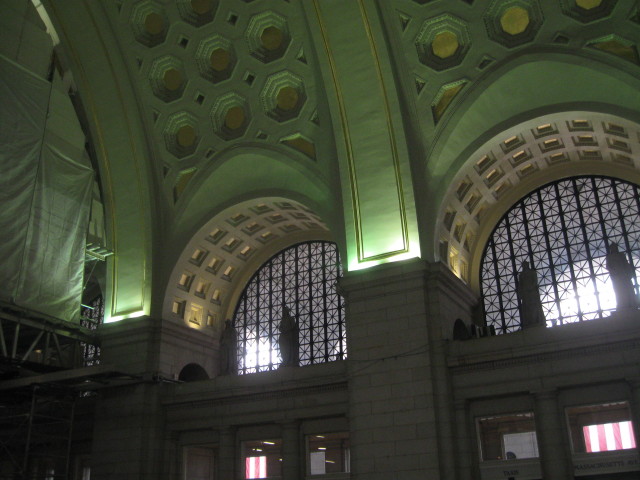
I returned to
ClubAcela, repacked my luggage and then waited. In the few
private lounges that I have been in, this one is in the top
range. Just to have the quiet from the main waiting area is
worth it, plus soft drinks and snacks too. And baggage storage
is a treat. About 8:15pm we were led to train 19, the Crescent
and car 1910, room 3. After boarding and getting settled in, we
were told to proceed to the dining car for our late dinner.
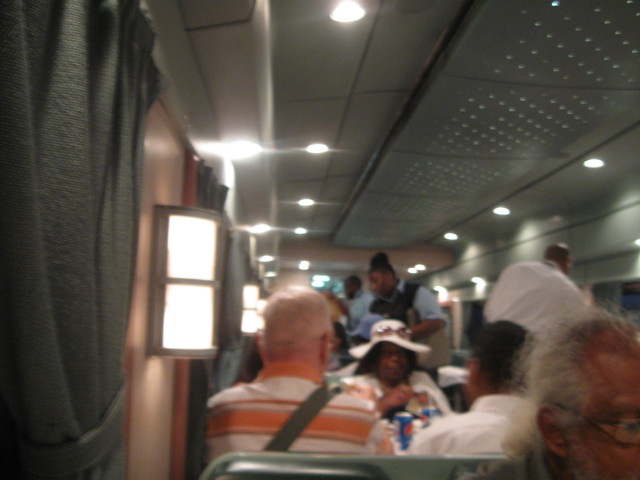
Dining car on the
Crescent where I had the Salmon
which was very good.
Afterwards I returned to my
room and prepared to spend my first night in the Viewliner
Roomettes with a non-enclosed toilet and wash basin. Upon waking
tomorrow I should be in the state of Georgia.
Tomorrow - Riding the
Crescent through the
south.
Return to last
Chapter Twenty-three - Day in Norfolk
Robin's trips
Home Page
Text and Photos by Author
The author retains
all rights. No reproductions are allowed without the
author's consent.
Comments are appreciated at...
yr.mmxx@gmail.com
